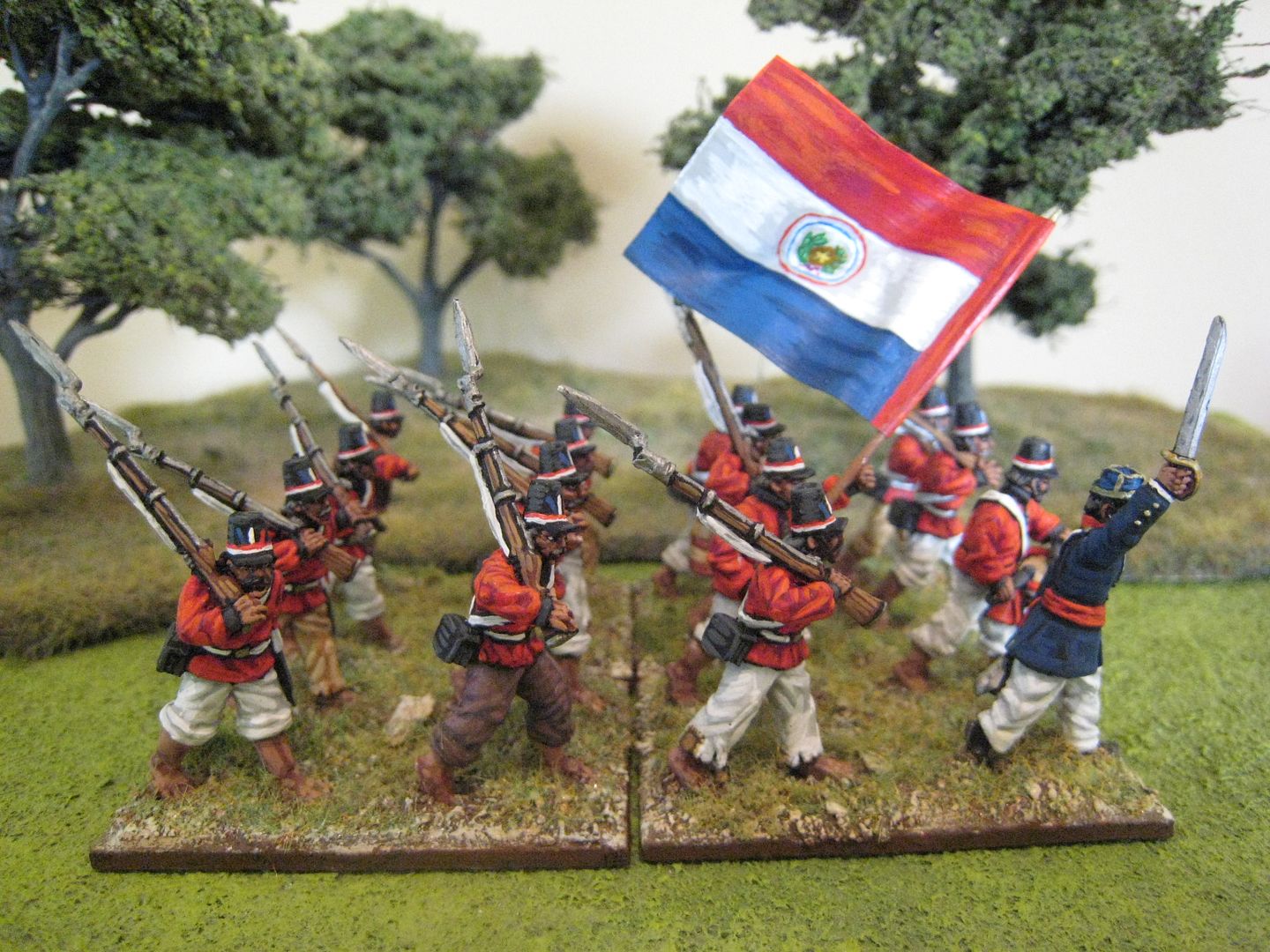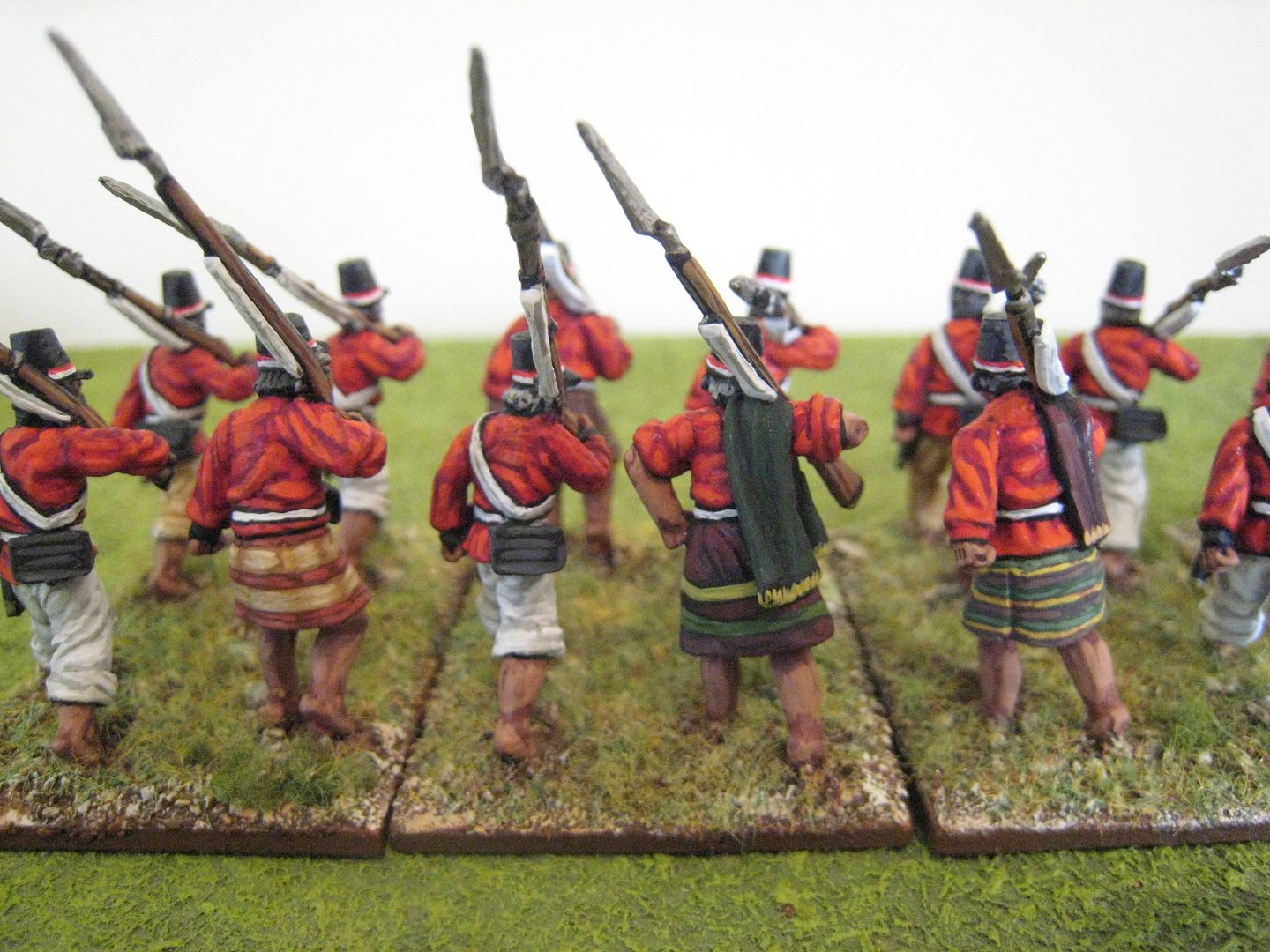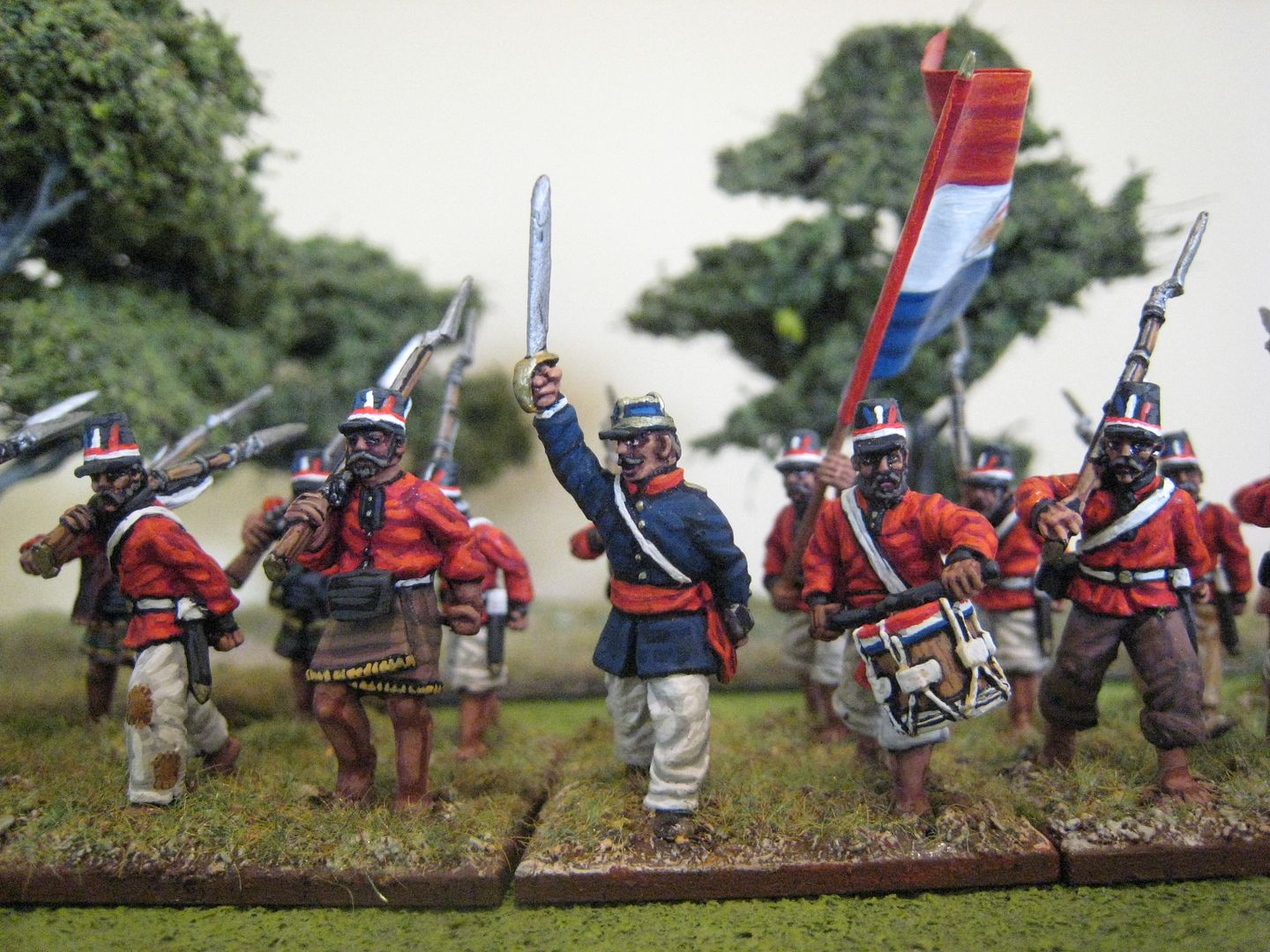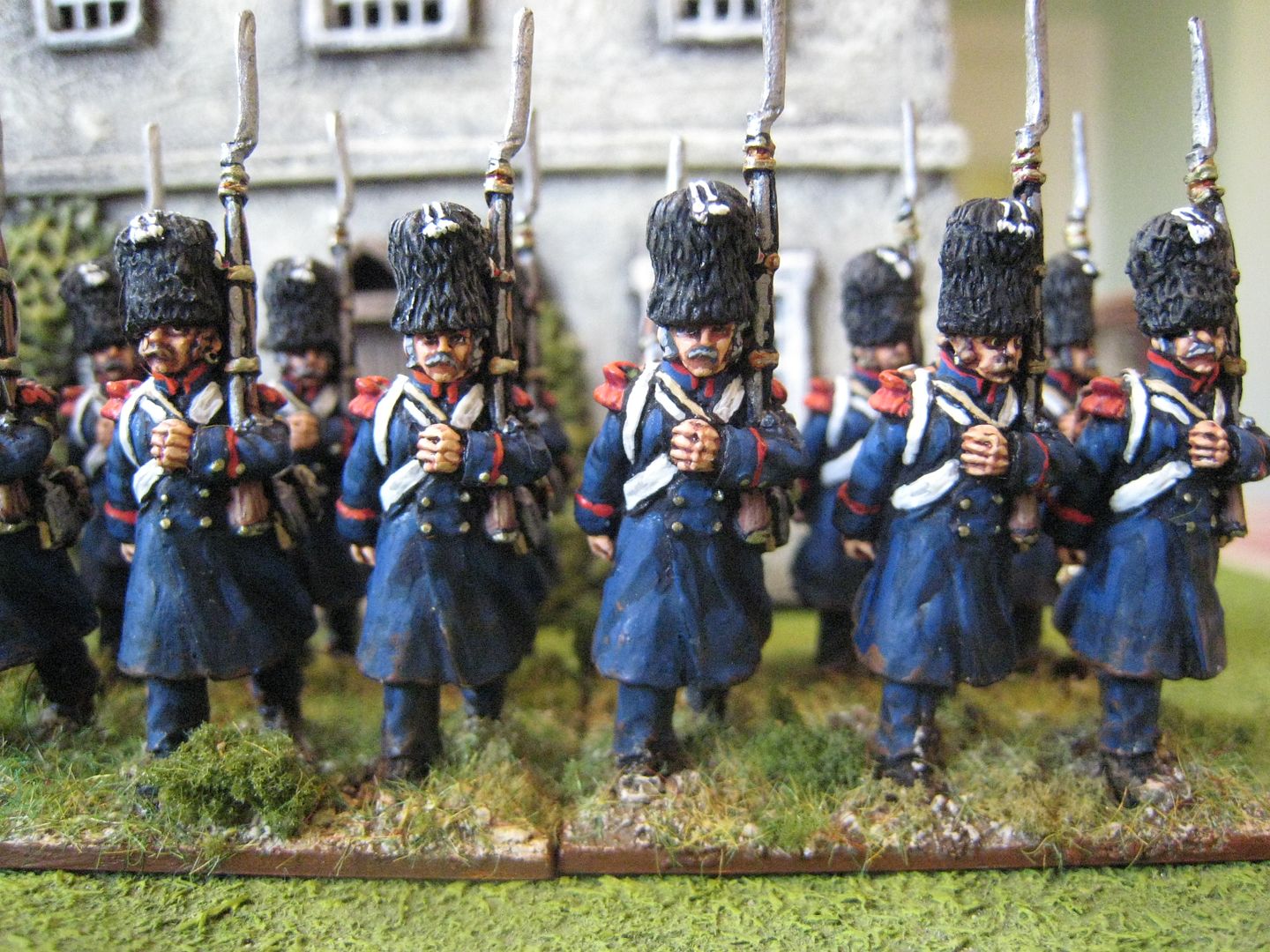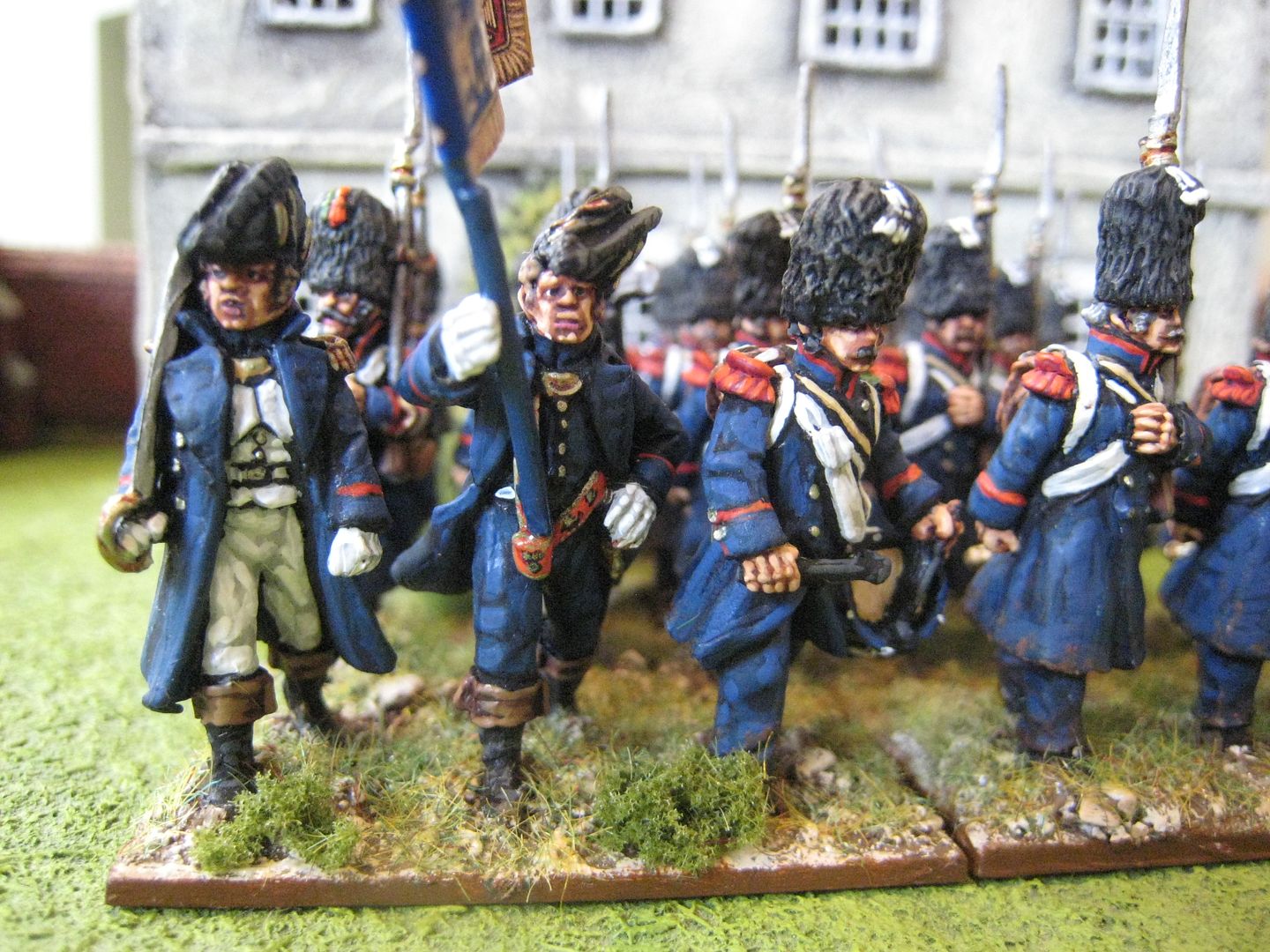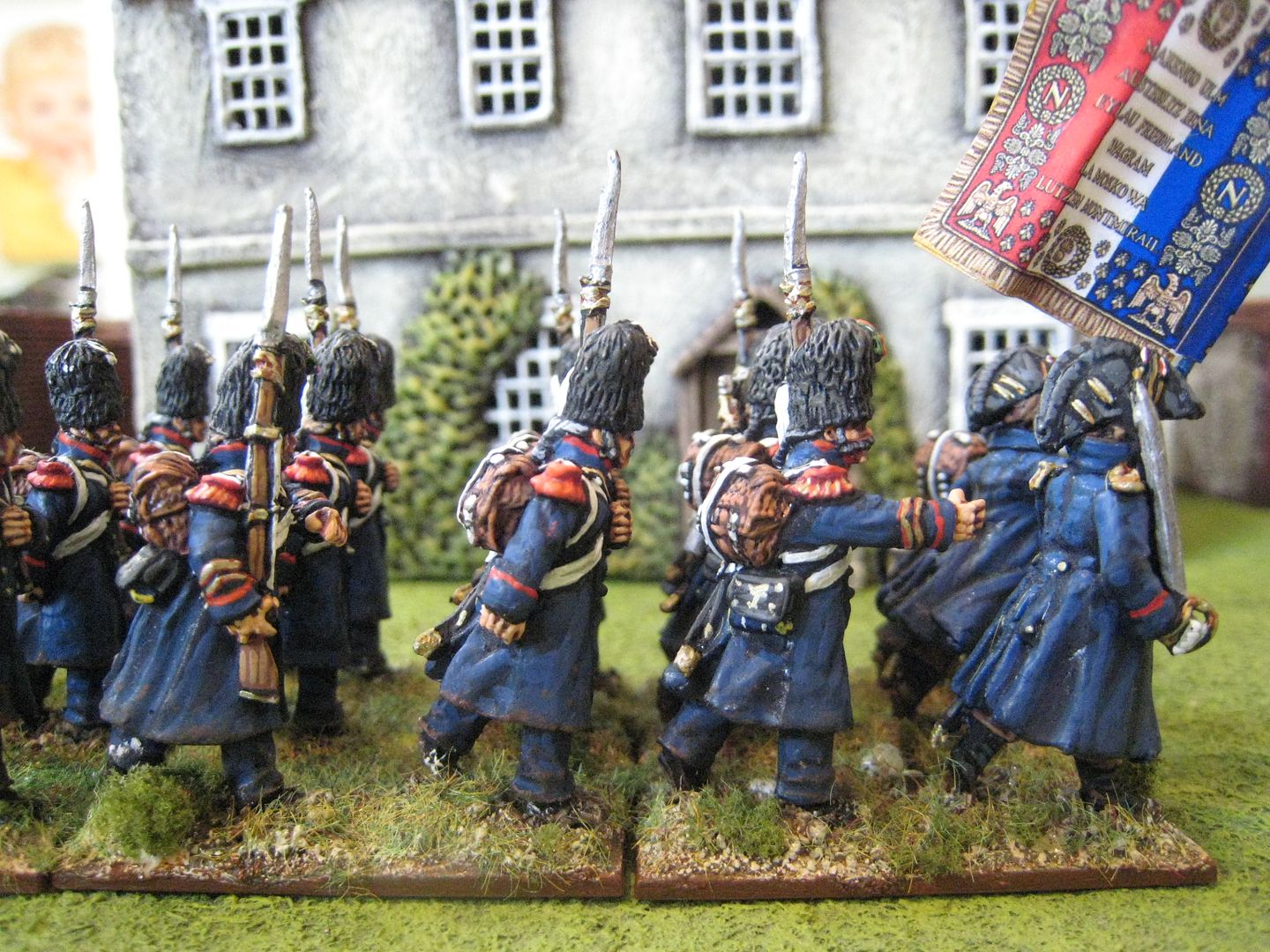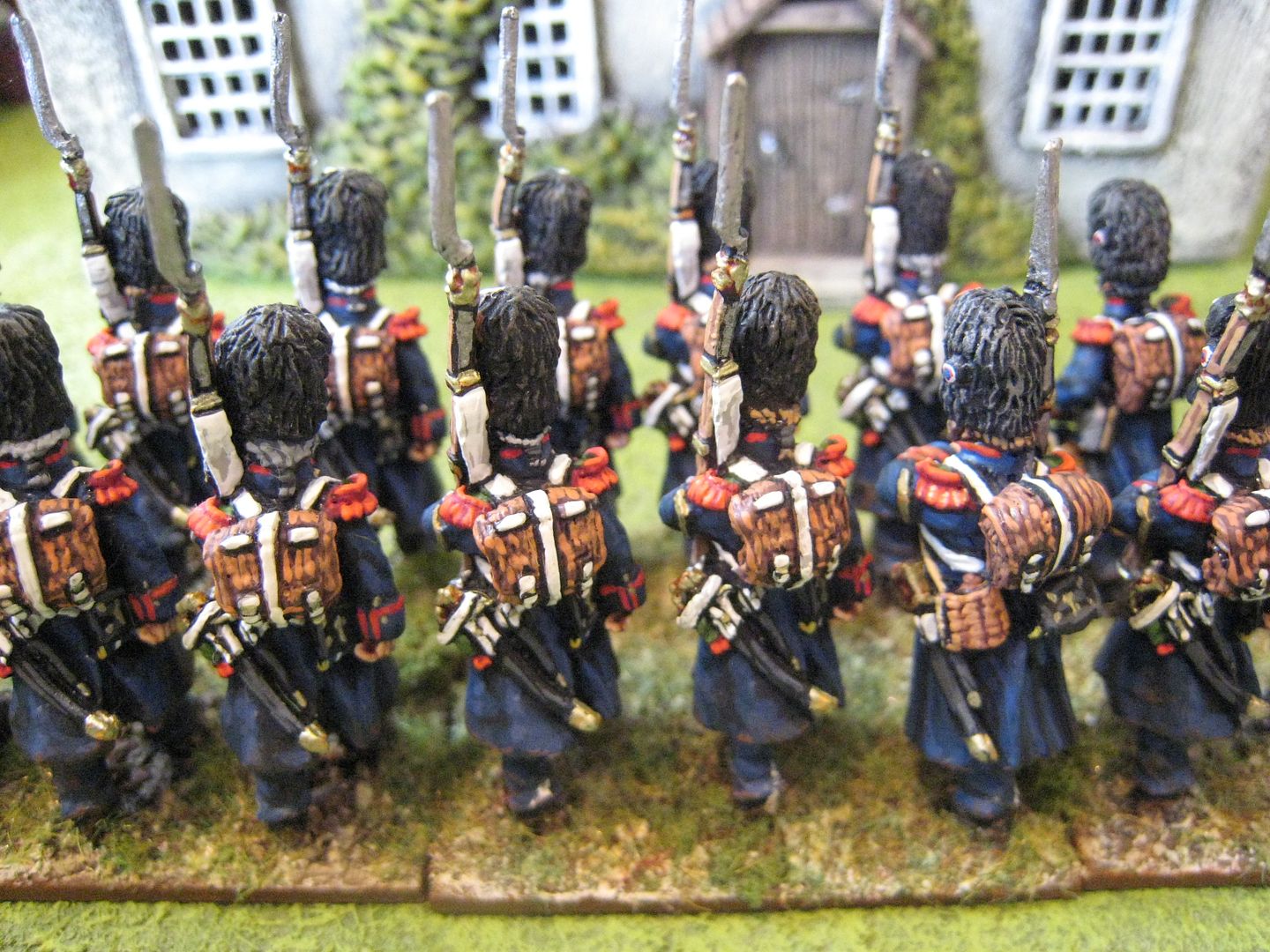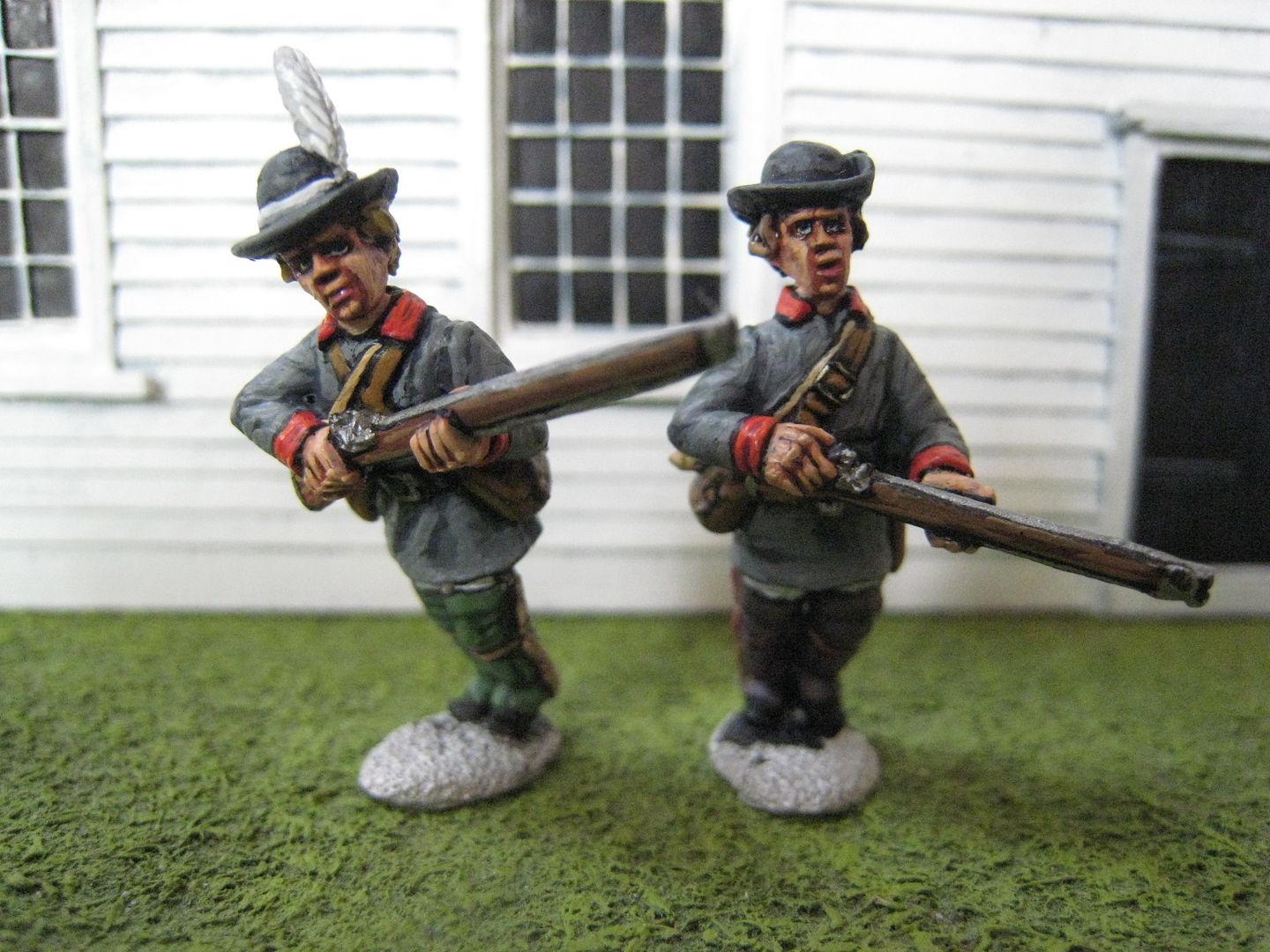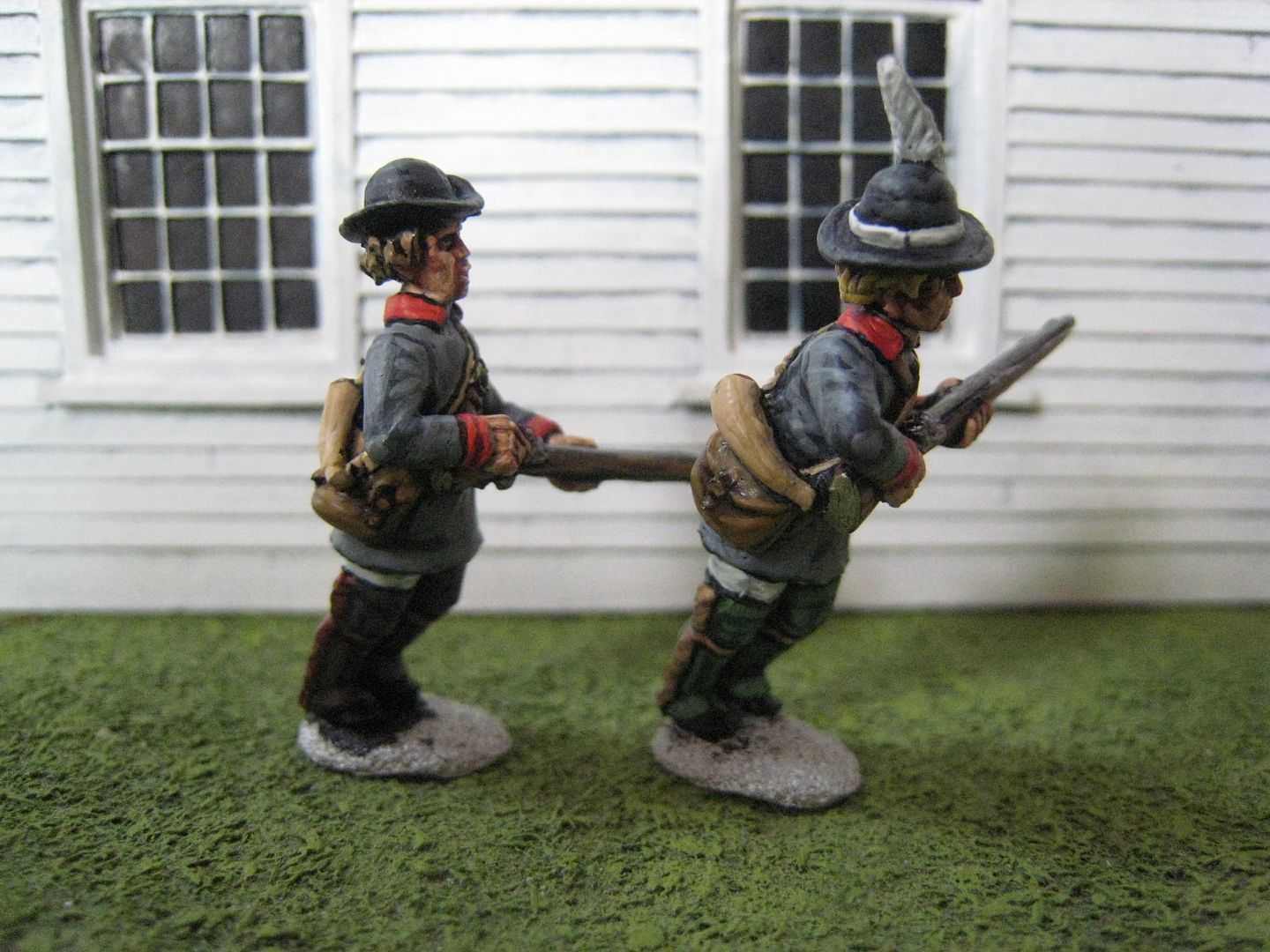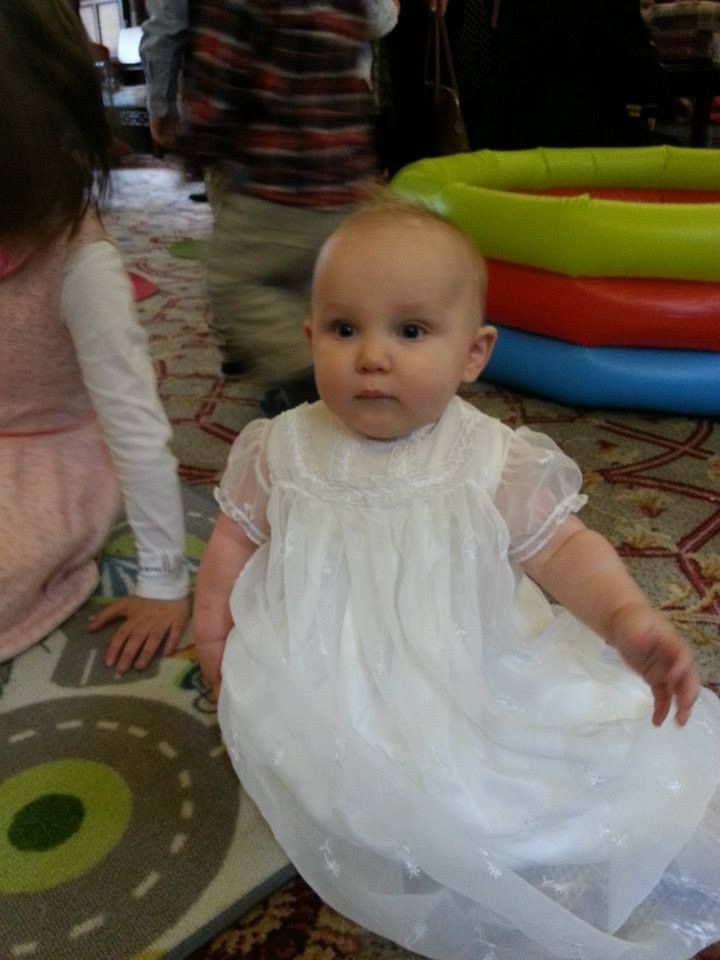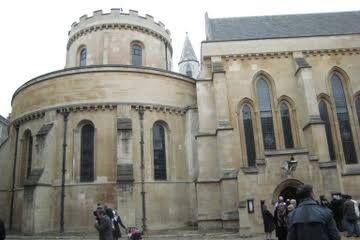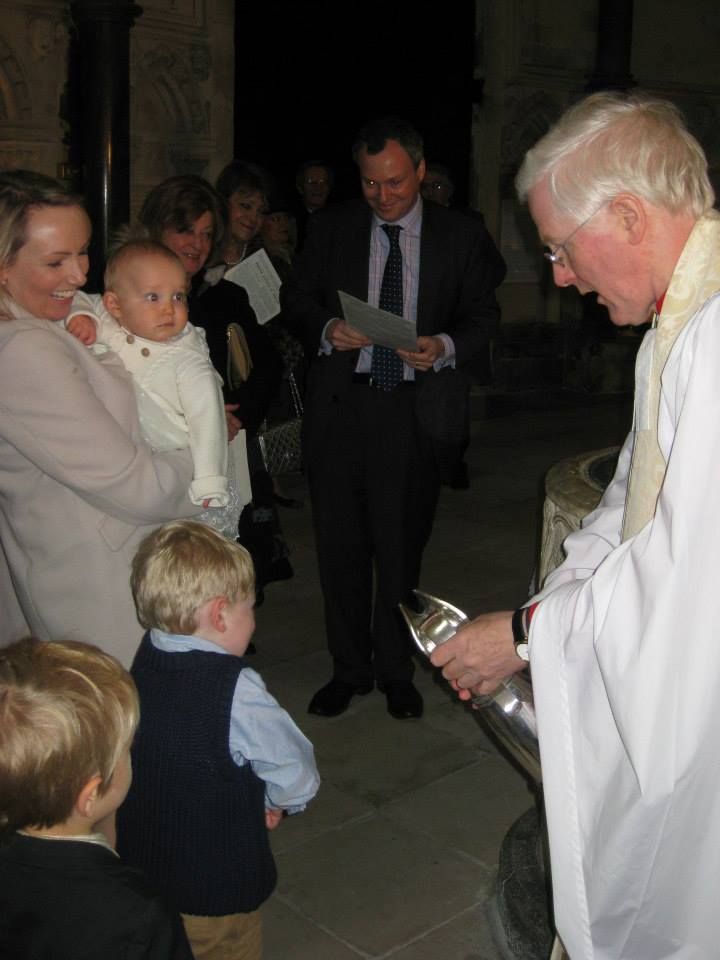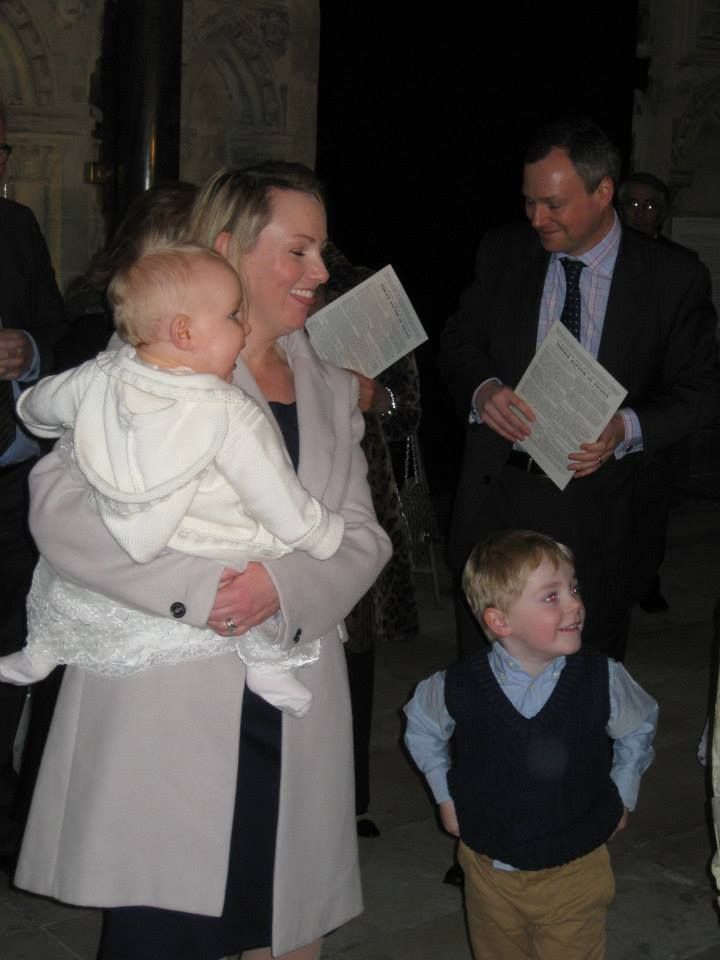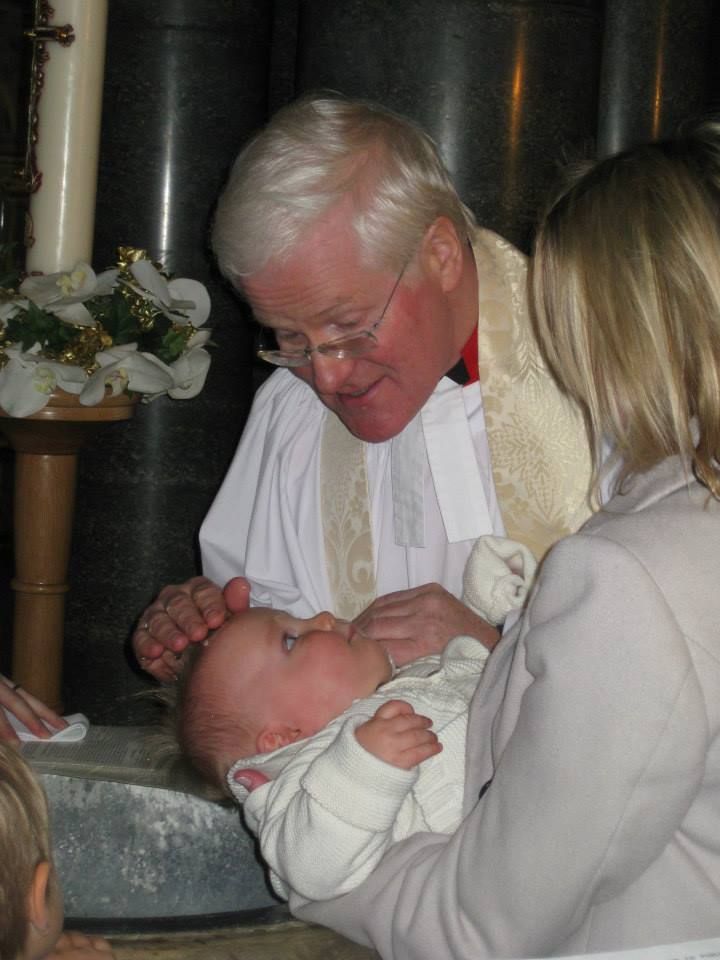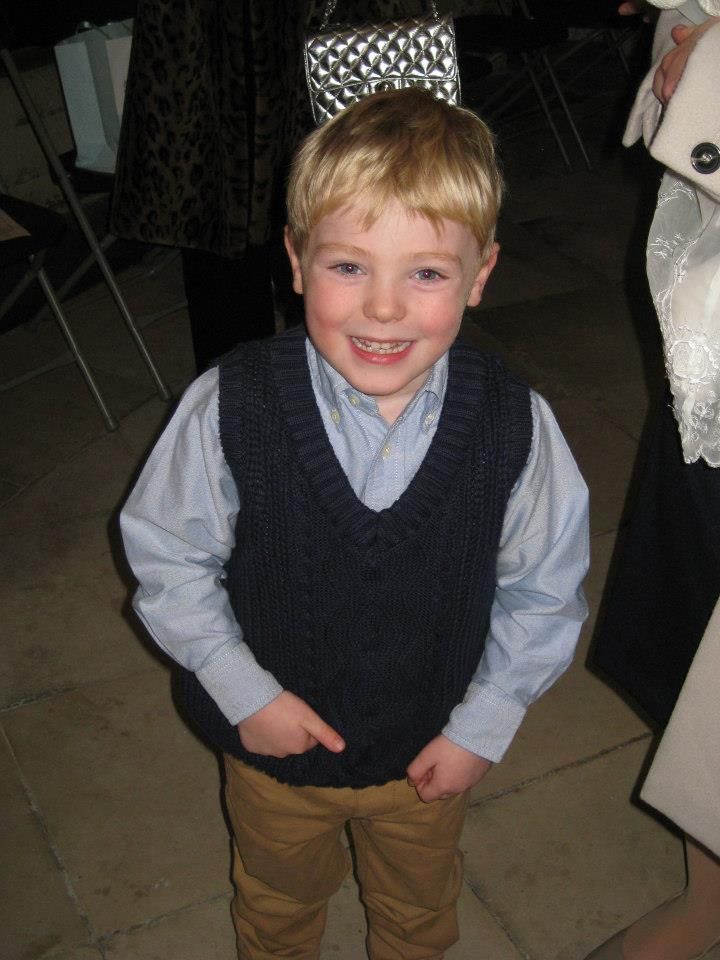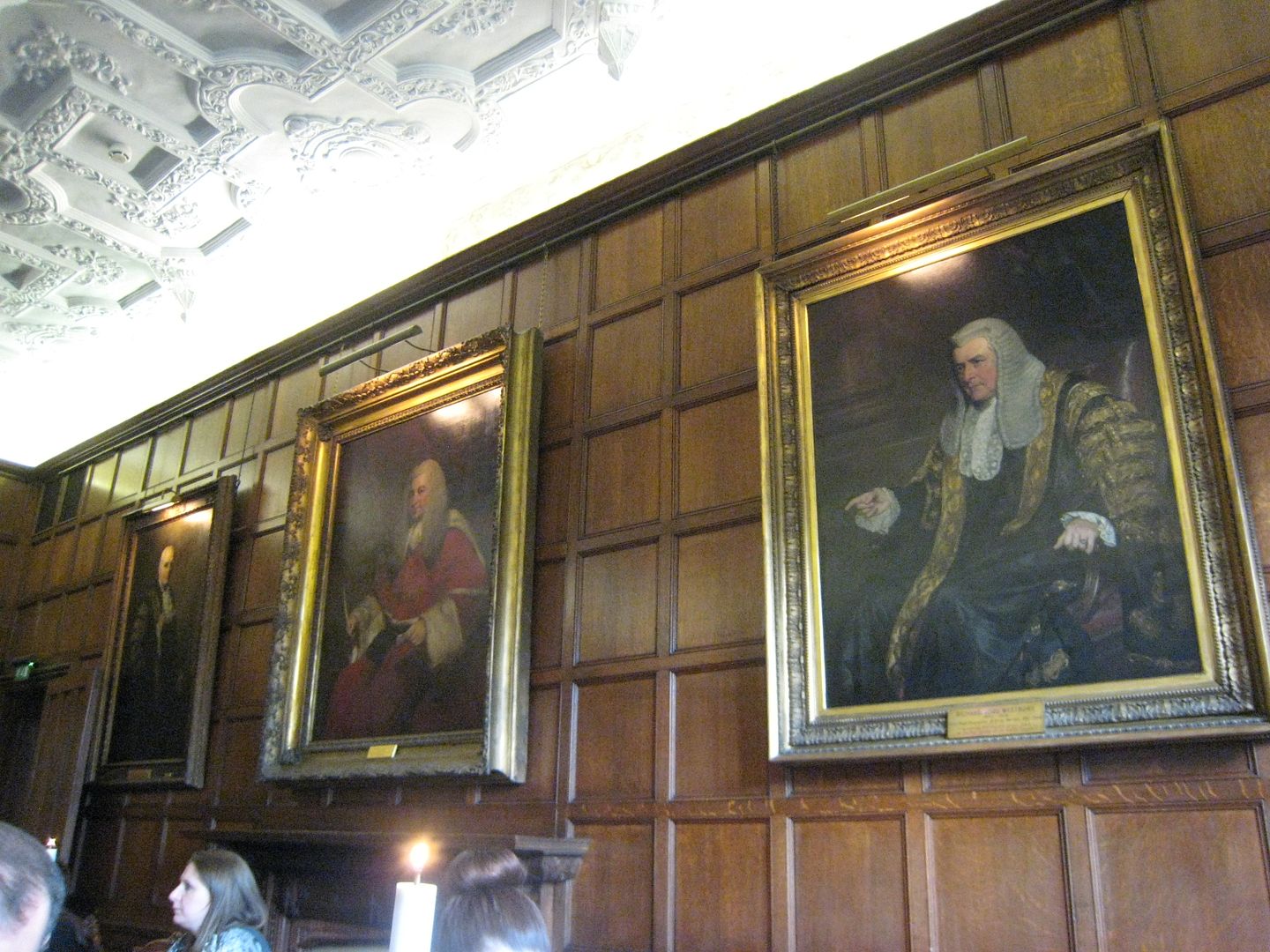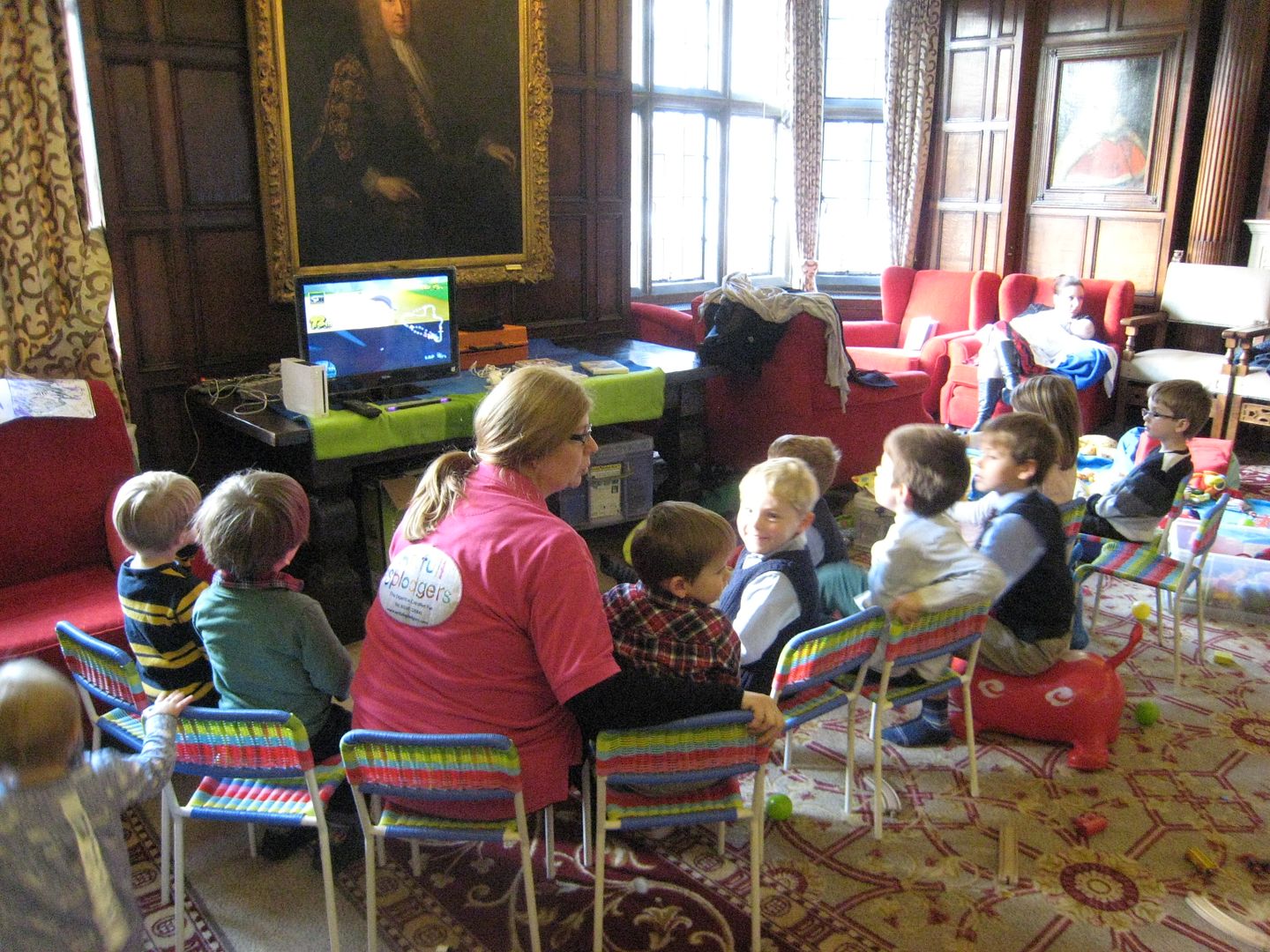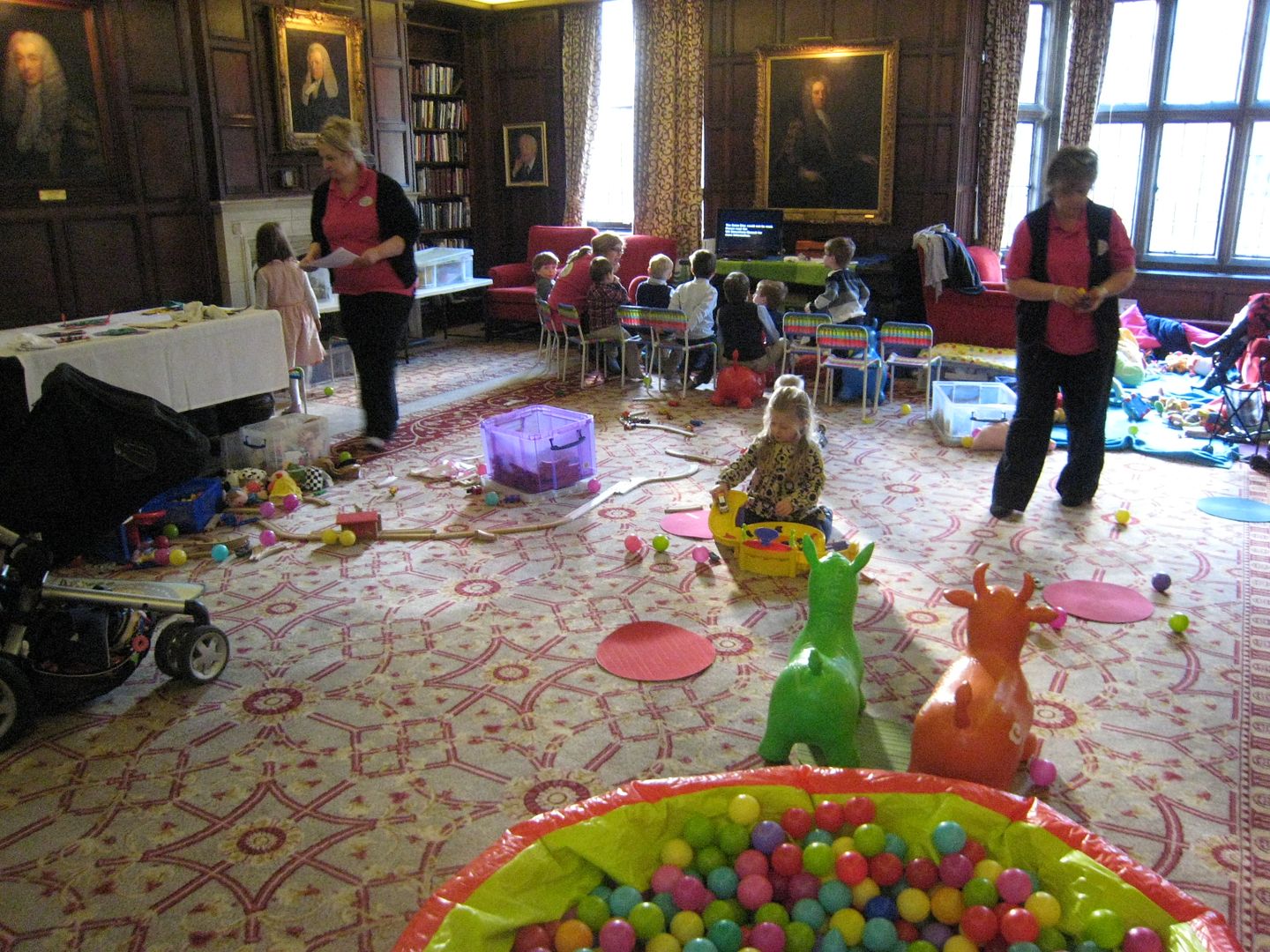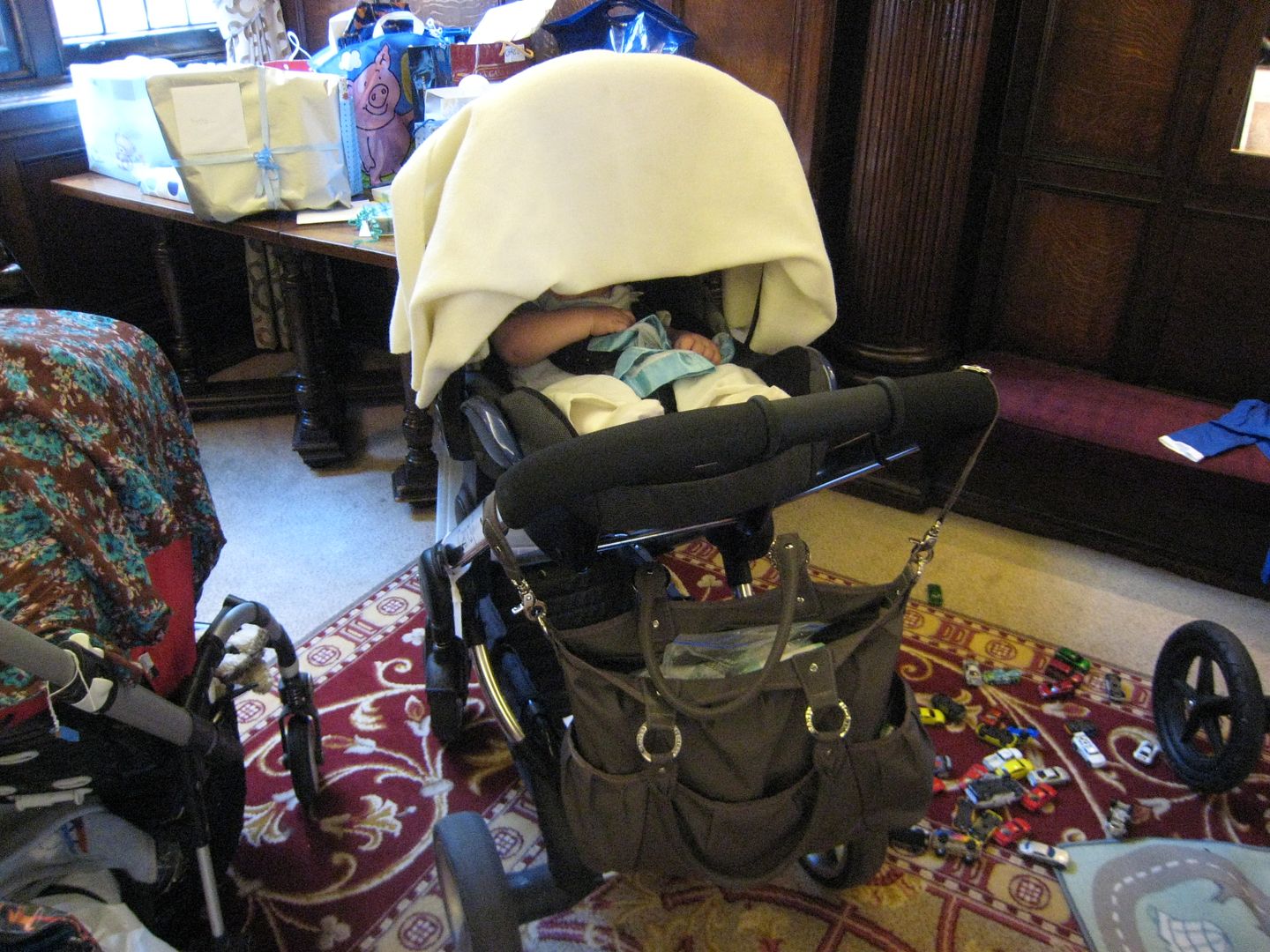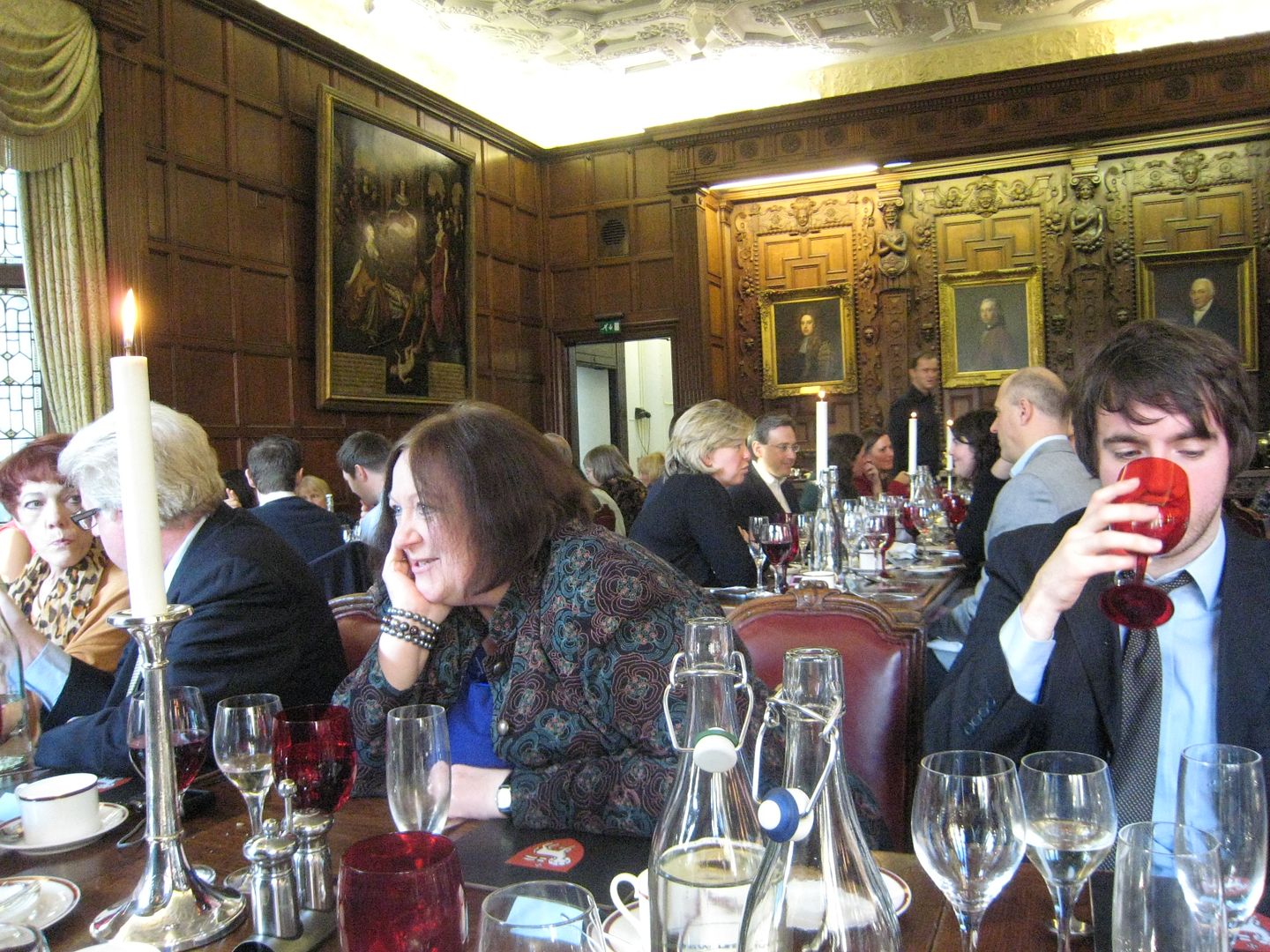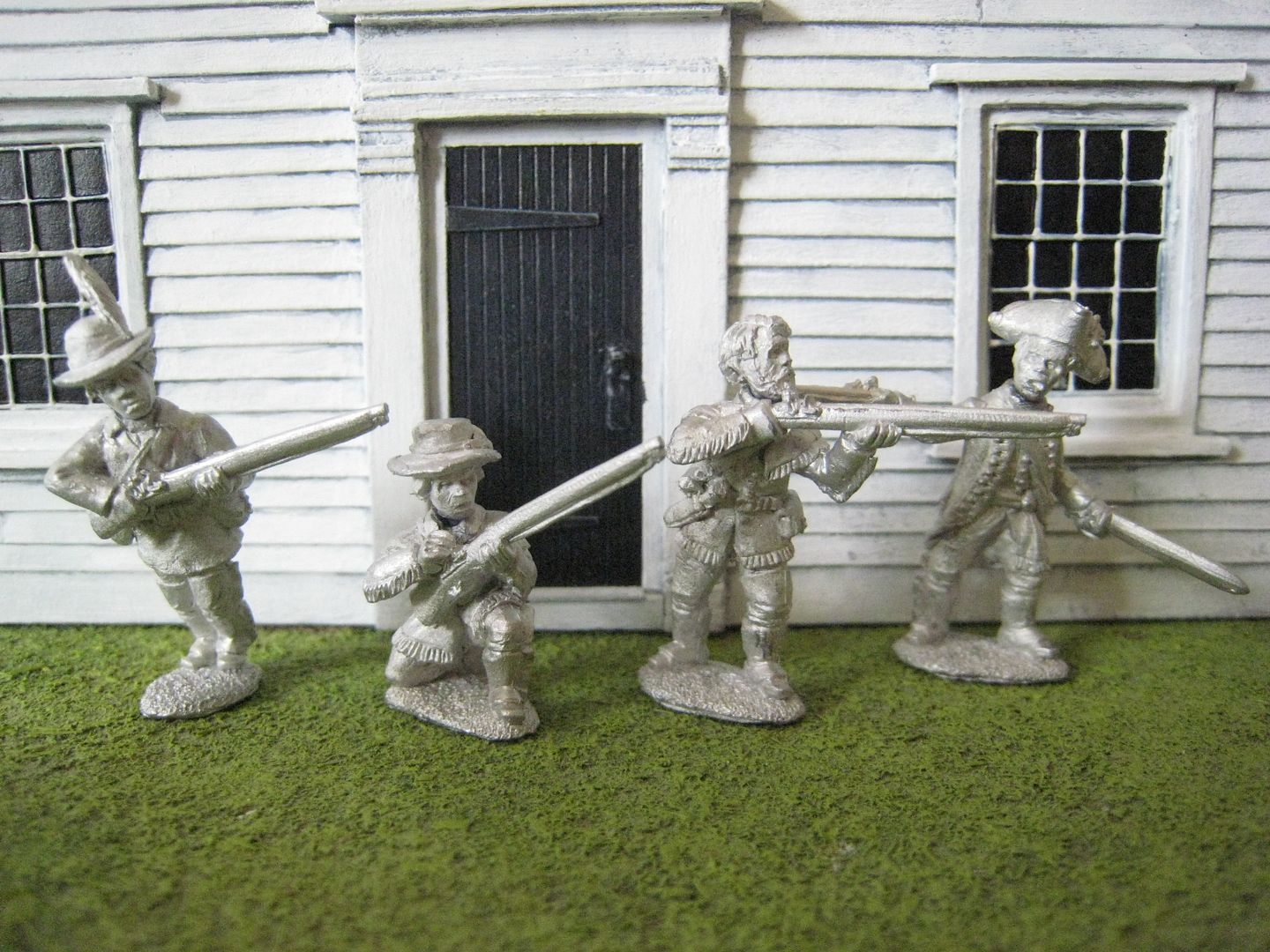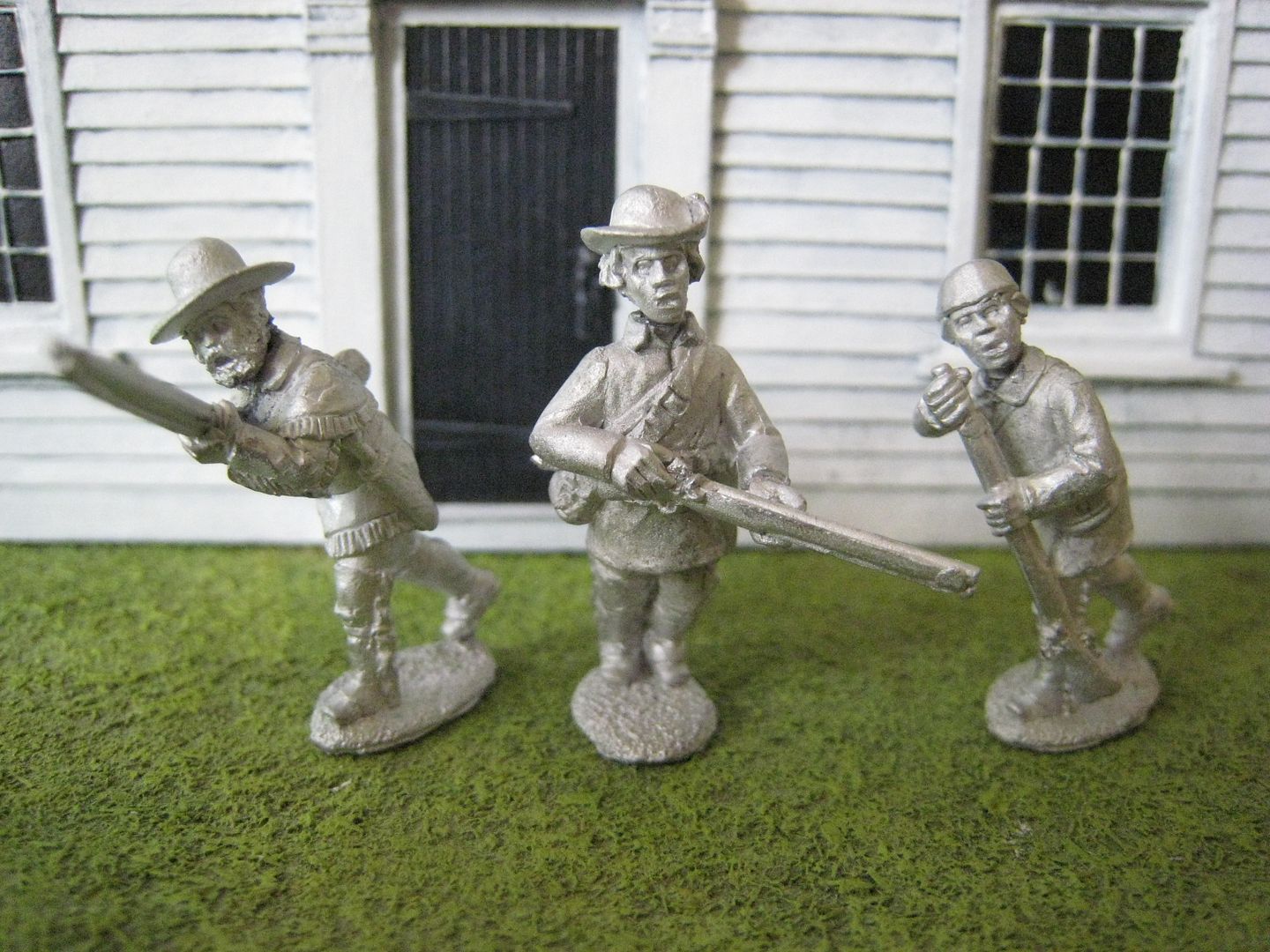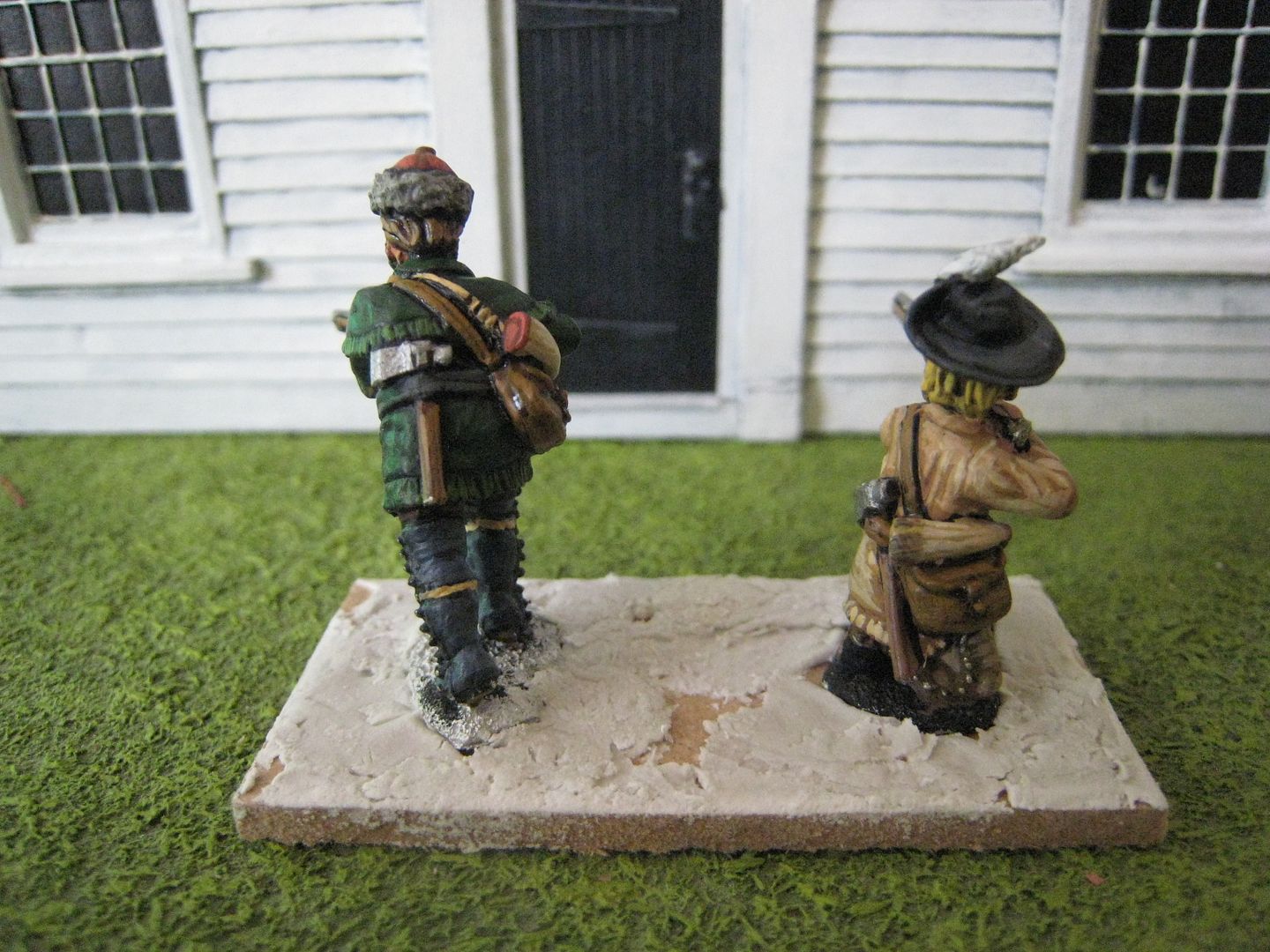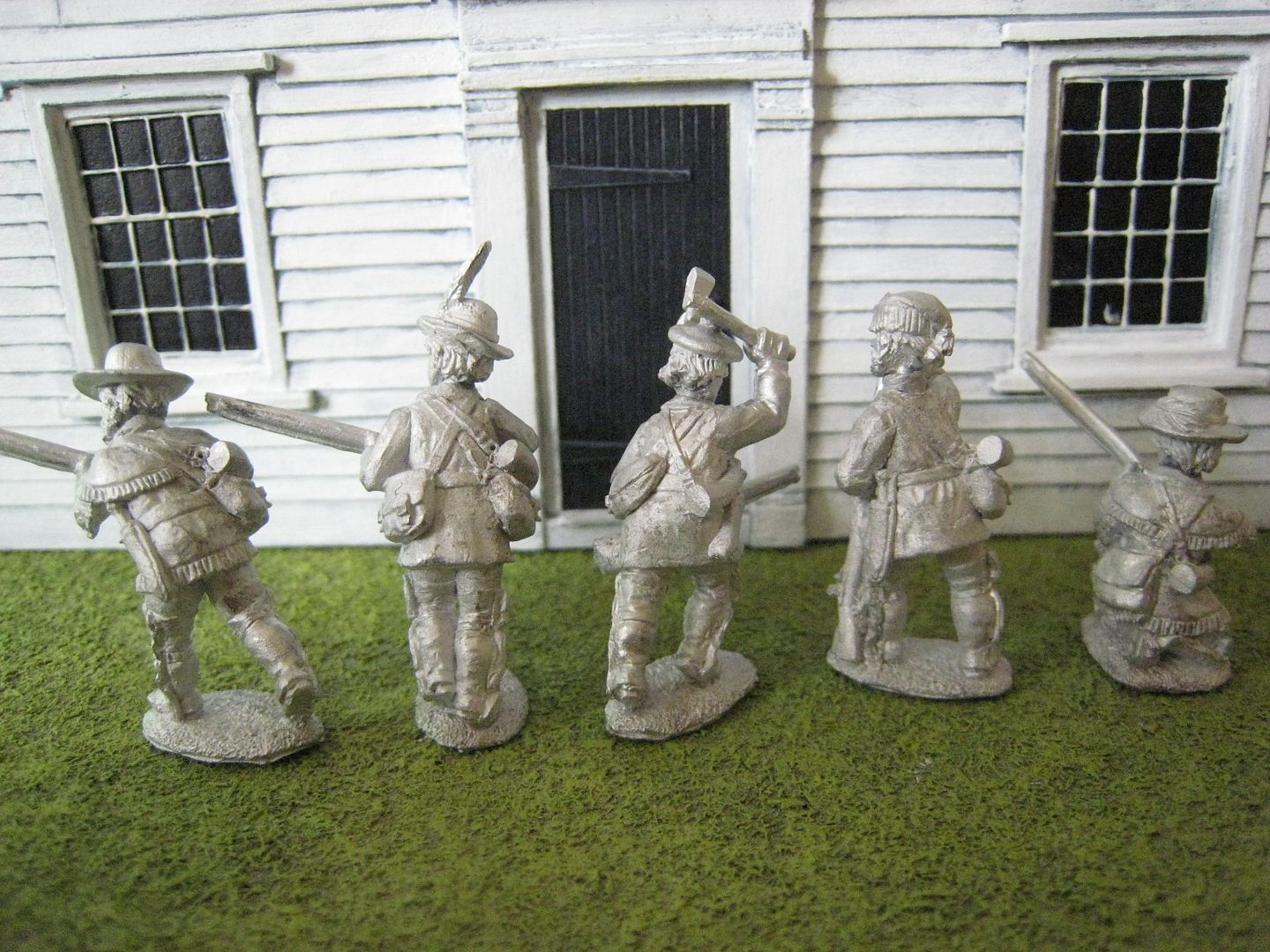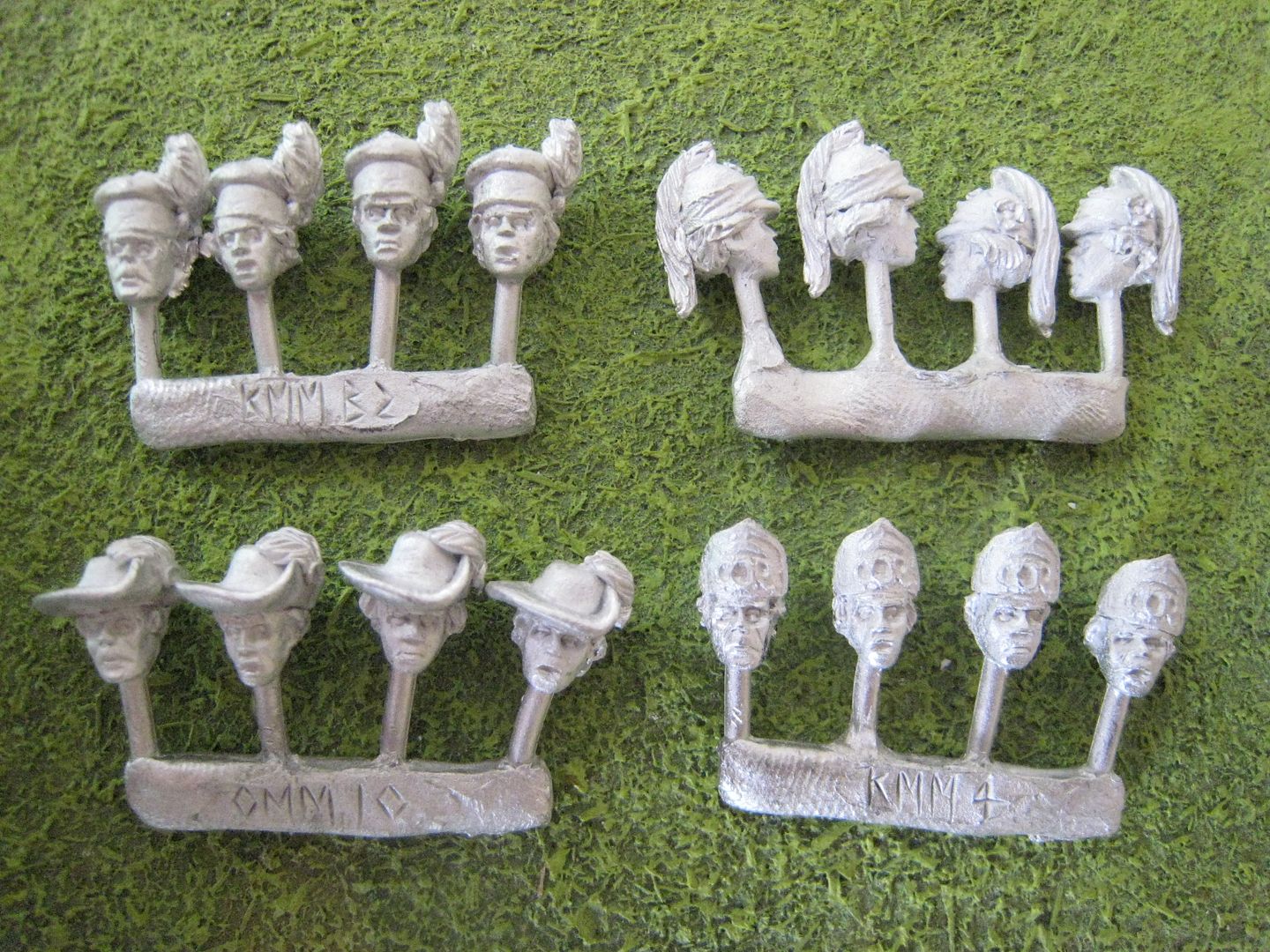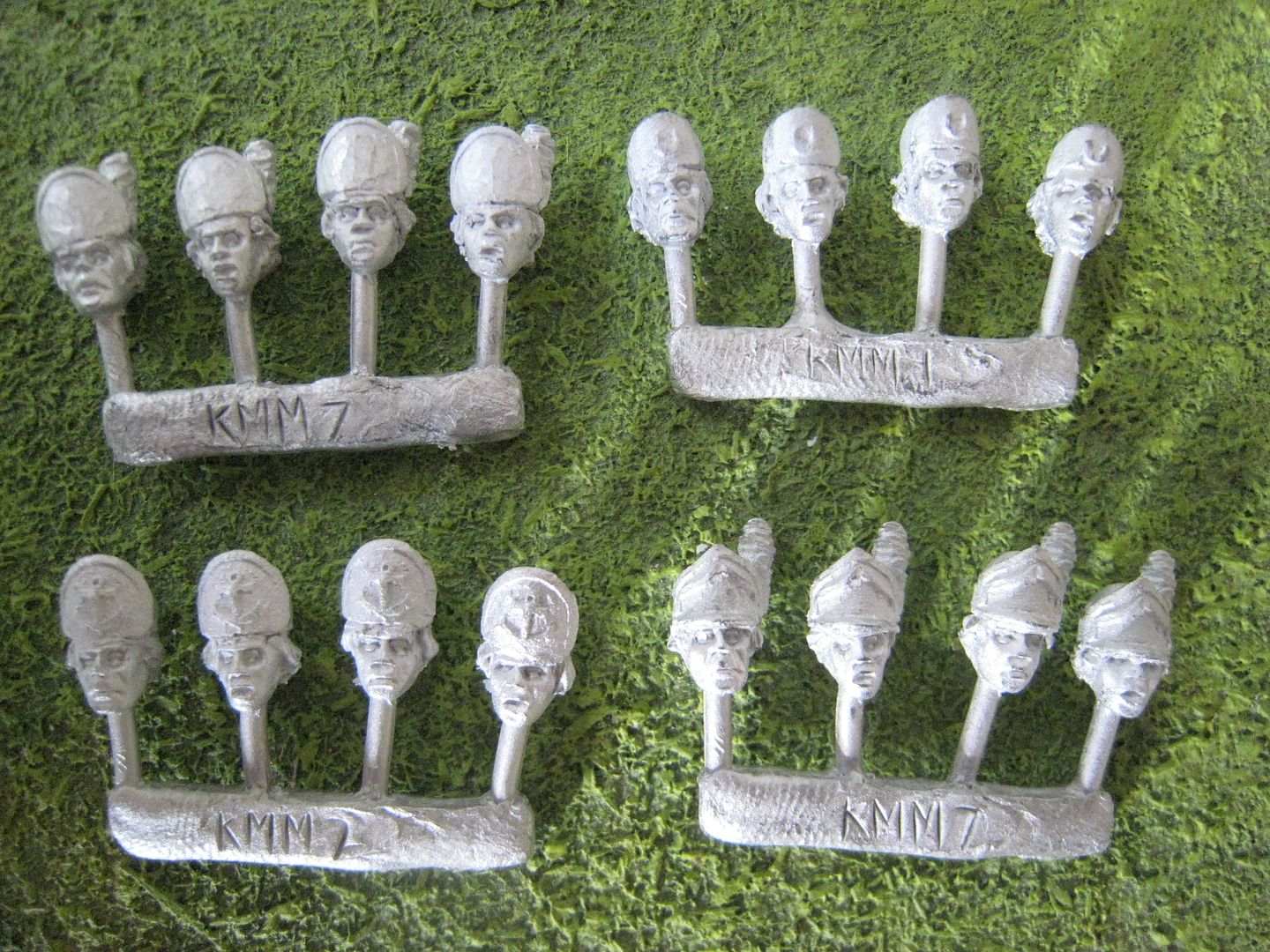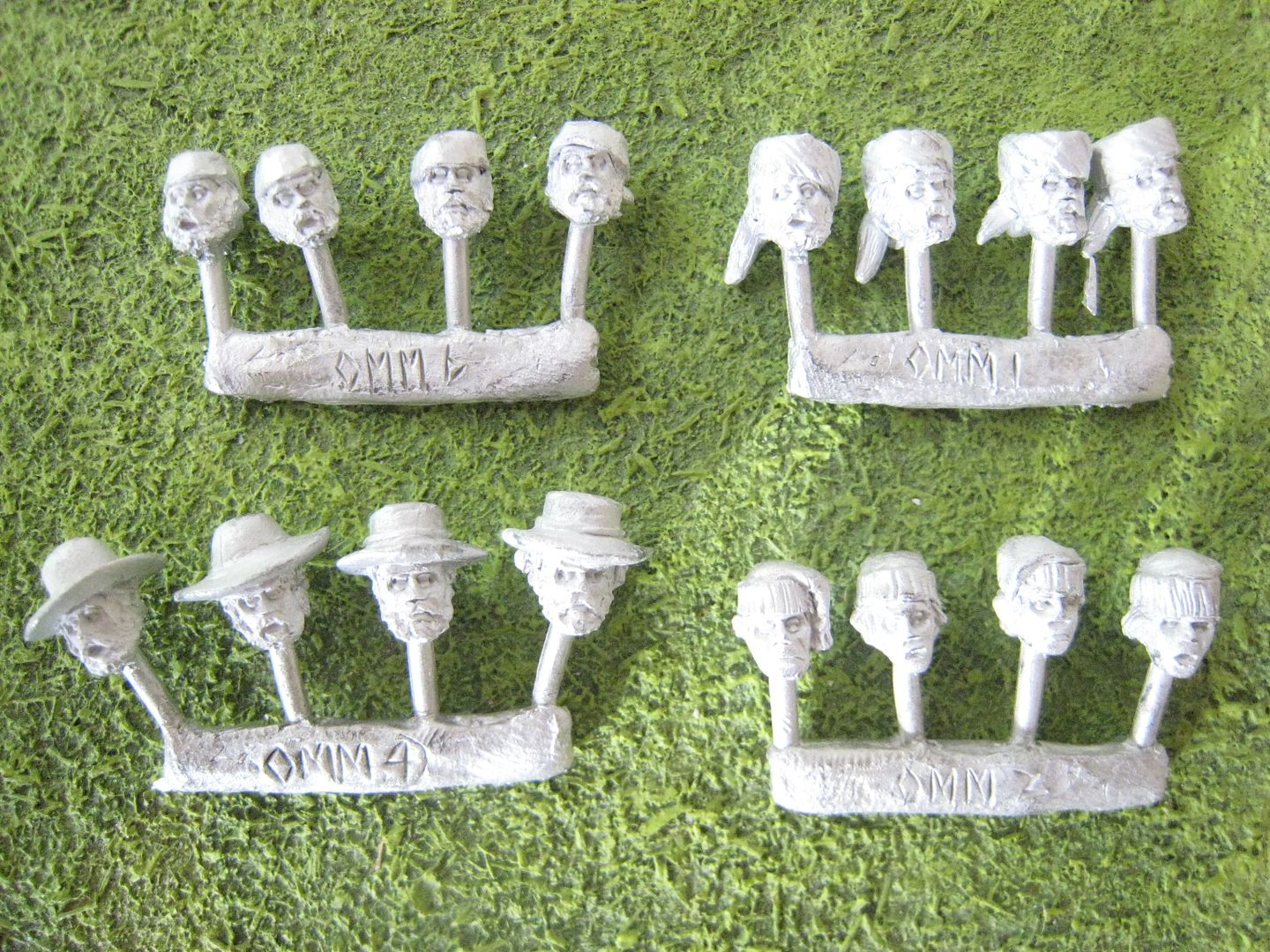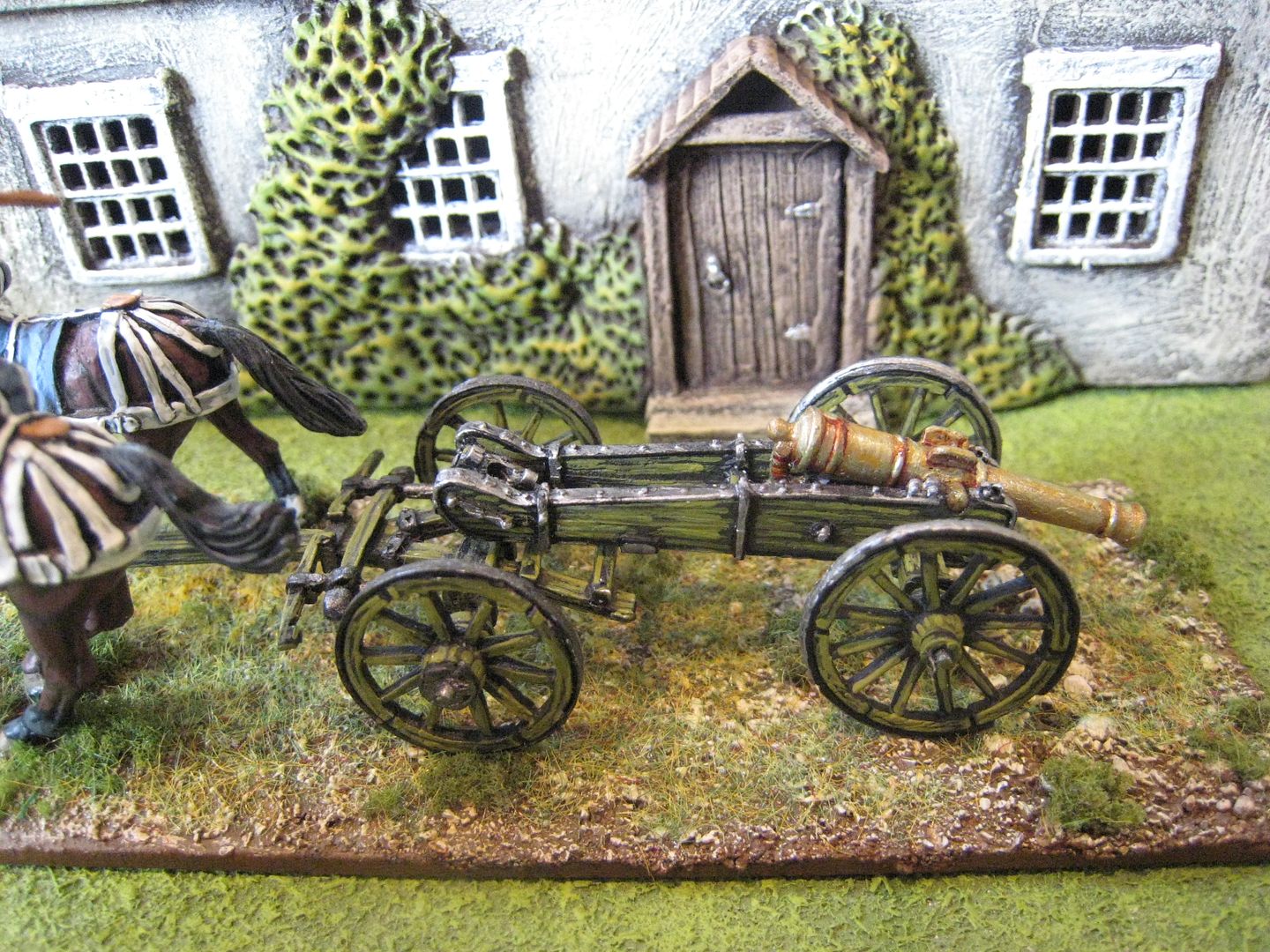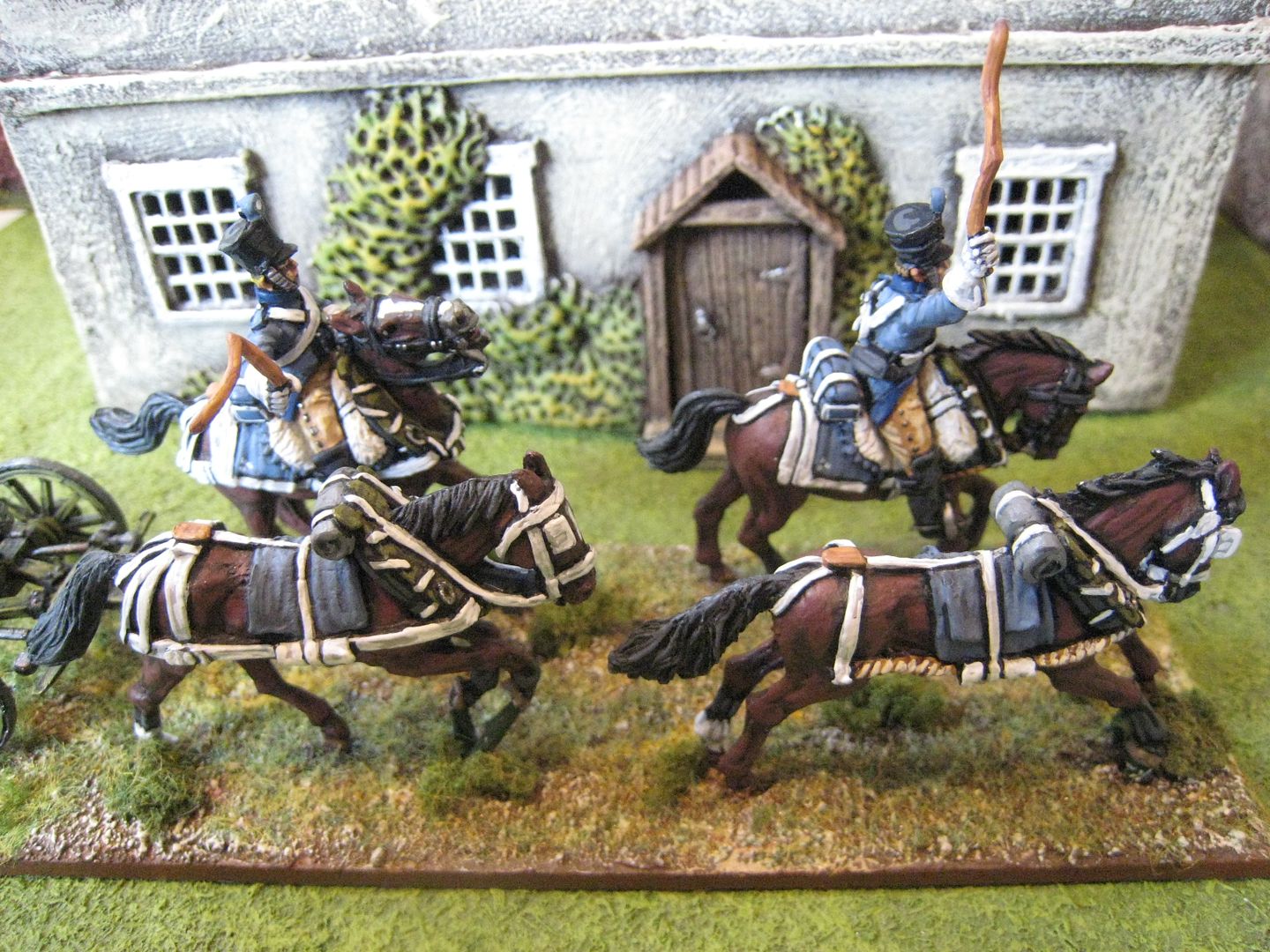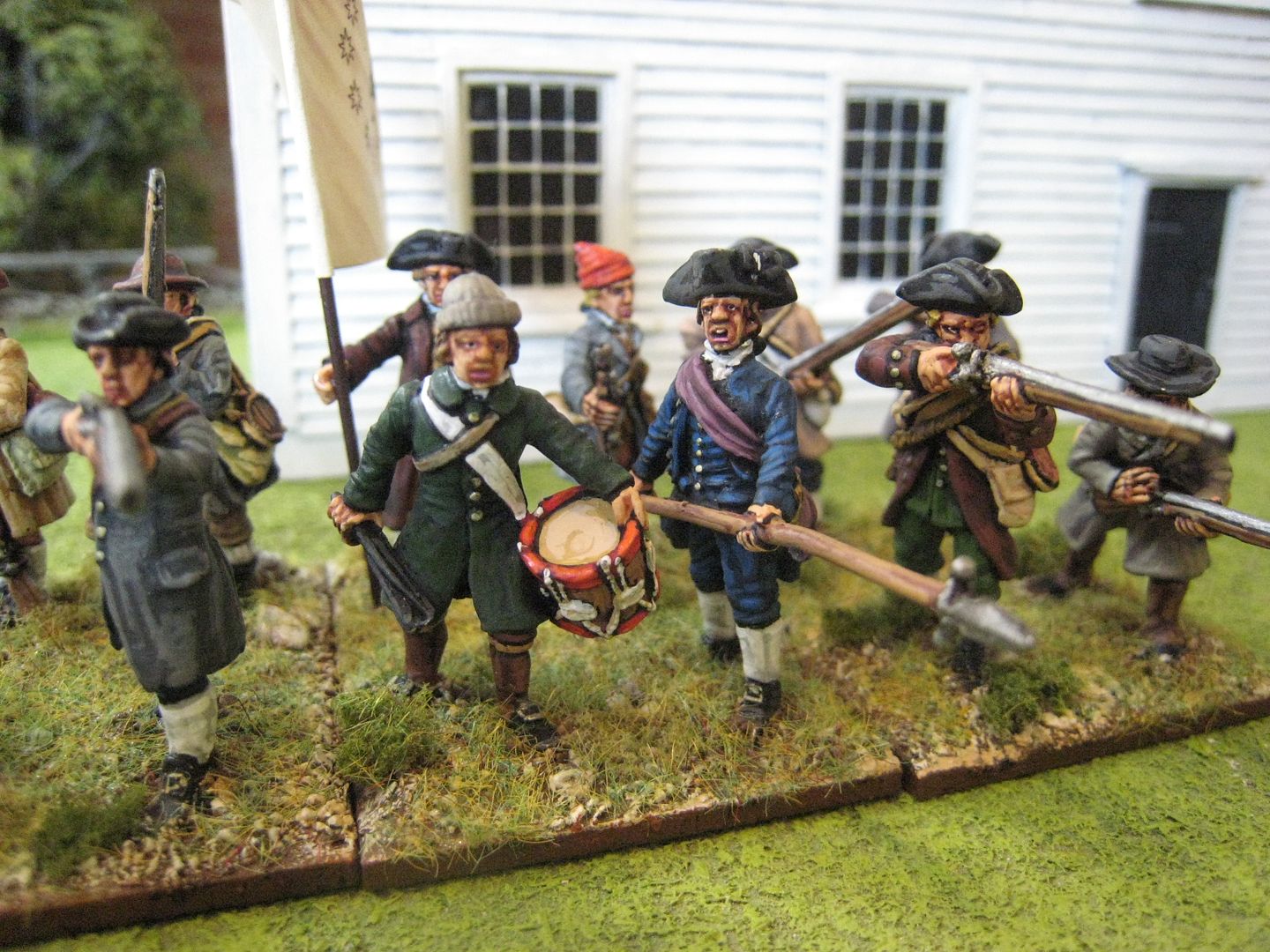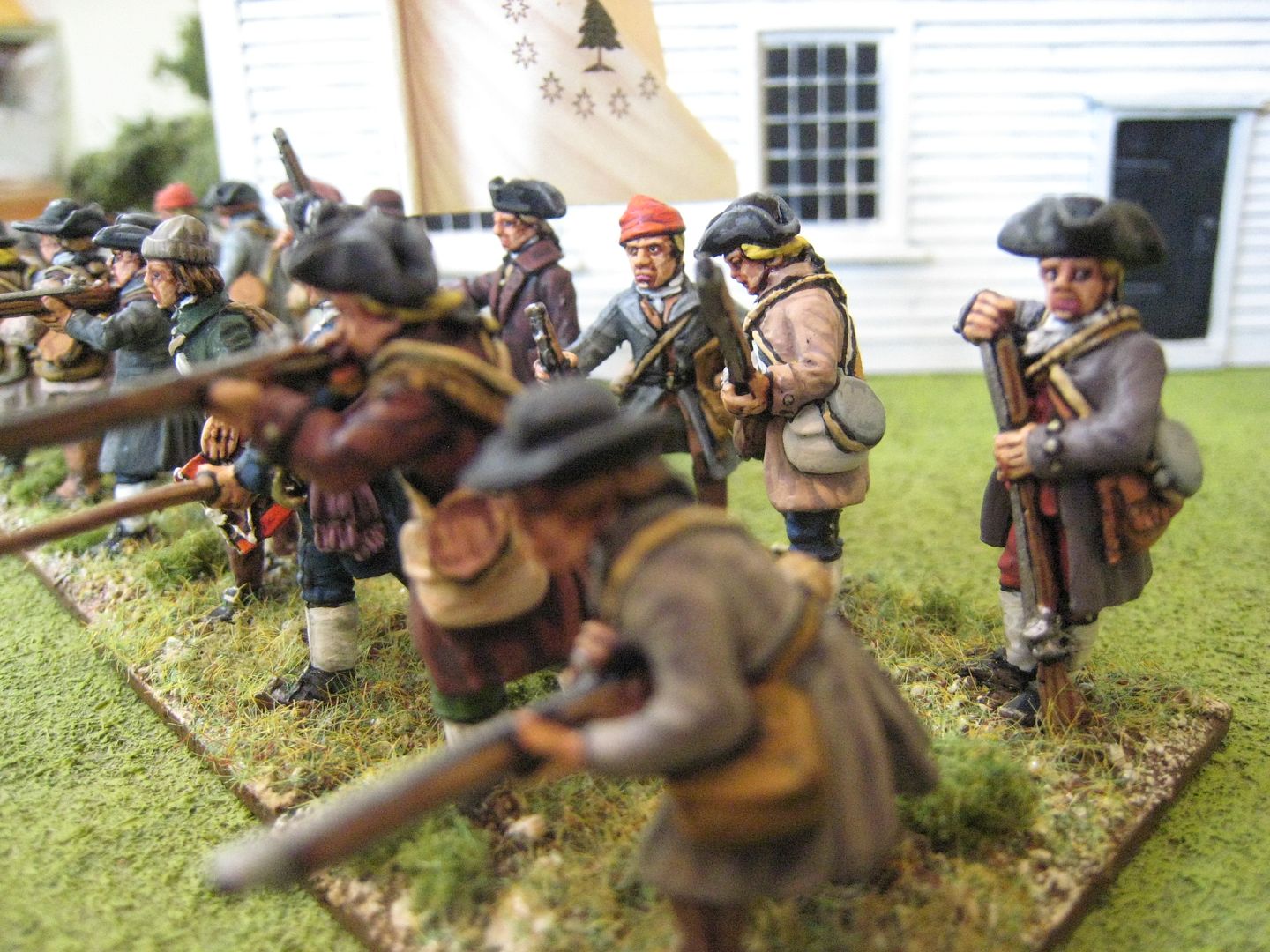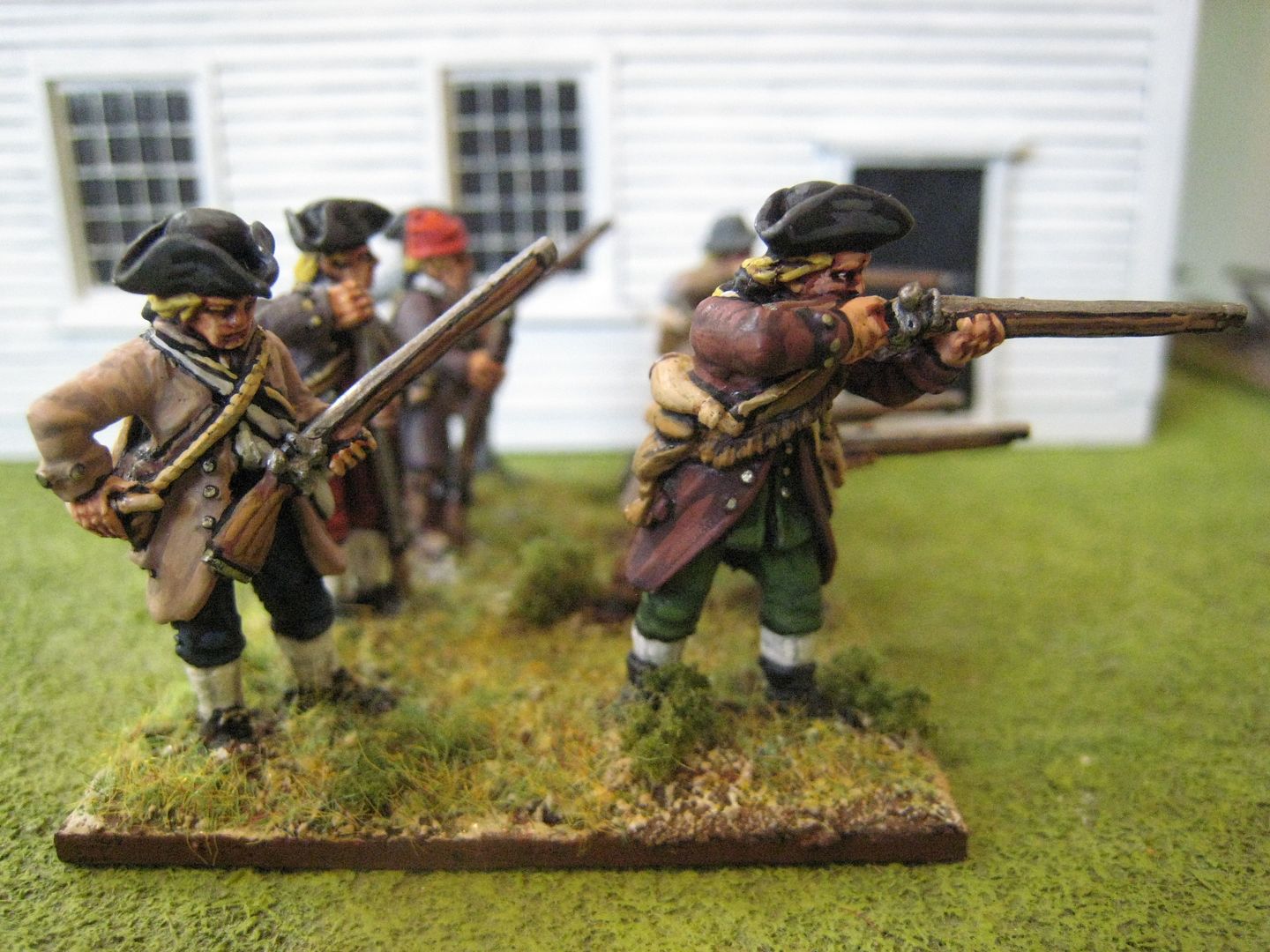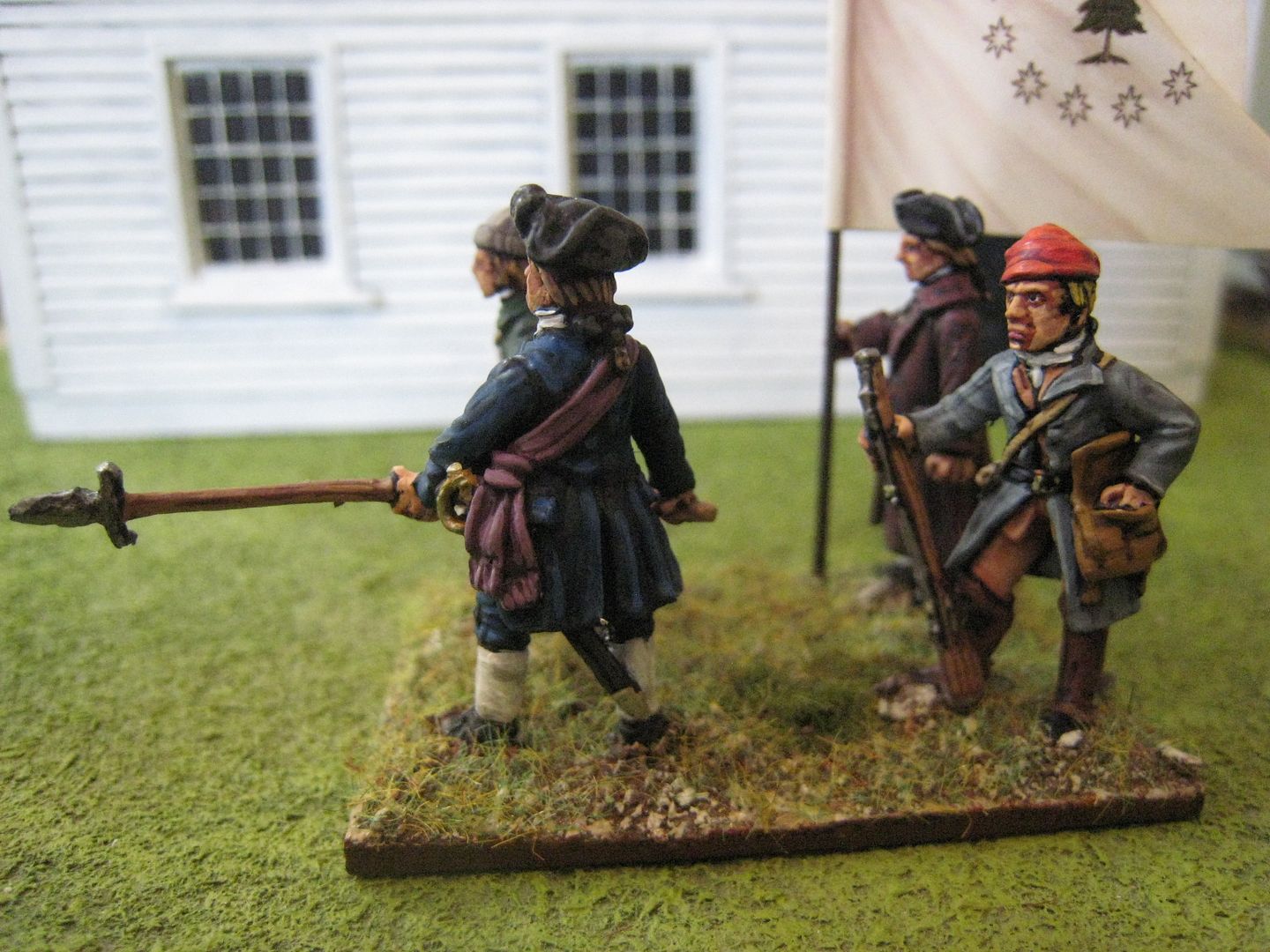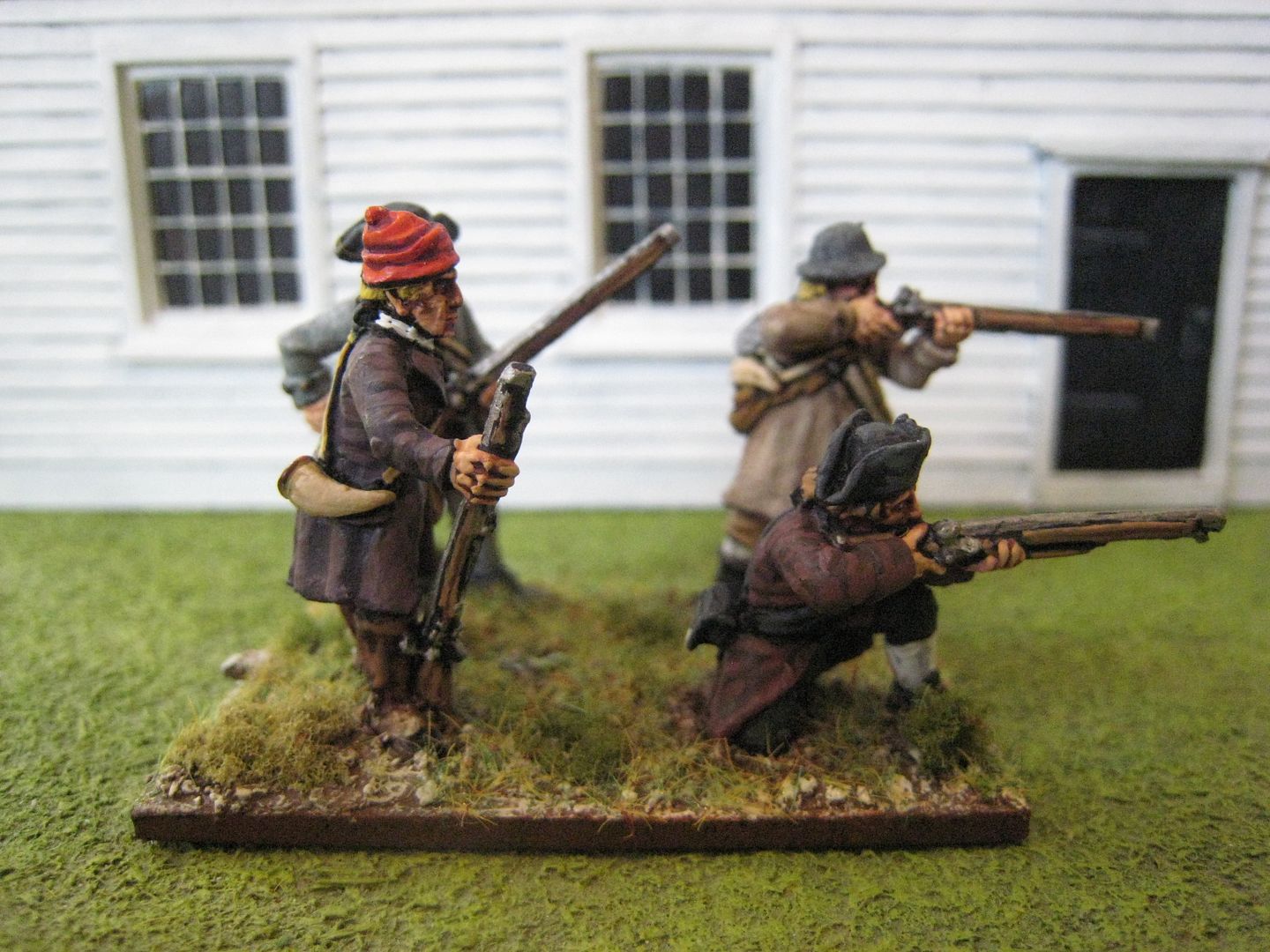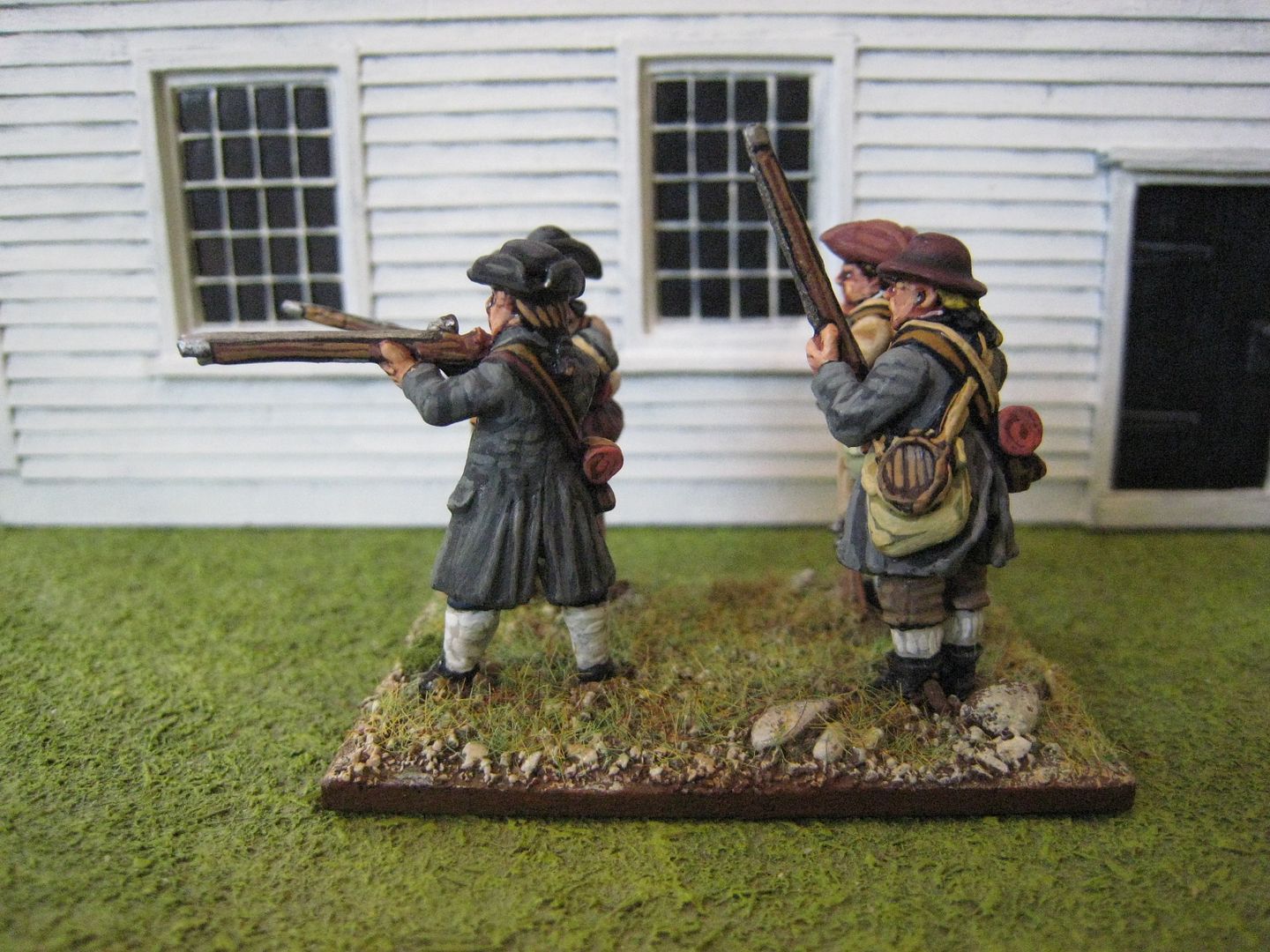...because we fly off to New Zealand later tonight. Our first time with both children and it's not looking good. Monty's decided to come down with a virus or stomach bug, which means regular nappy changes and constant screaming. Nice. Hugo, I suspect, will want off the airplane about 20 minutes into the flight. I don't think he'll like being told there's another 27 hours to go.
Anyway, thanks to everyone who follows and comments on this blog. I'm very aware that I'd been bad of late at leaving reciprocal comments on other blogs - I do look at them, honest! I'll make a much bigger effort in the new year. Above is a picture of "Project X", which I'll post about when I return. It features my two wargaming NZ pals who live in the same city as my in-laws, so I get to meet them every time we visit. On the left is "Valleyboy" and on the right "Captain Chook" from the WD3 forum. People who know these excellent chaps will, I hope, recognise something of them in these figures.
A very happy Christmas to all.
Friday 20 December 2013
Thursday 19 December 2013
First Paraguayan War unit
Just a quickie because I'm in a mad rush trying to get everything done before flying out to New Zealand tomorrow, but I thought I'd post these photos because they are of my first completed unit of Kingscarbine Miniatures' Paraguayan War figures. The war, which lasted from 1864 to 1870 and saw Brazil, Argentina and Uruguay united against Paraguay, was a particularly nasty one which resulted in massive losses for the Paraguayans (at least 30% of the country's population appears to have died). I'll post something about the course of the war as this project develops, but there's a decent Wiki article on it here. Kingscarbine Miniatures are available in the UK from Empress Miniatures.
Kingscarbine Miniatures have released 3 packs of Paraguayan infantry. The standard Paraguayan outfit was loose trousers and a red shirt with black triming. Headgear was a black cap with a band in the national colours of red, white and blue. The KCM packs are line infantry, militia infantry and command. The militia have blankets and skirts (I'm sure there's a proper name for what they're wearing...) rather than trousers. I've added a couple of militia figures to this unit to bulk it out a bit but also to suggest the inclusion of battle replacements. The militia figures should probably be wearing white shirts as opposed to the "uniform" red and black ones, but I've kept them in red and added a bit of black trim. For some reason line infantry officers often wore dark blue tunic coats, which is basically what the Brazilian infantry wore. The flag is hand painted because I don't think anyone makes the Paraguayan flag in 25mm yet. The obverse side has the the national coat of arms of Paraguay (a yellow star surrounded by a green wreath capped by the words REPUBLICA DEL PARAGUAY), all within two concentric circles while the reverse has aa yellow lion below a red Phrygian cap and the words Paz y Justicia ("Peace and Justice"). I don't mind admitting that I find drawing/painting circles one of the hardest bits of freehand. I painted this flag in a bit of a rush the other night and didn't use a compass or anything like that.
It took a while to decide what to use on the bases. I've never been to Latin America and so have no first hand knowledge of what the ground looks like. After seeing some contemporary paintings fo the war and photos of the battlefields, my usual mid/light green scatter seemed to work, although I decided to drop the bushes and undergrowth bits and bobs that I often add to other periods' figures. As always with a new period, I'm not sure where this one's going to go. But these figures are dead easy to paint and they're certainly colourful.
20 figures. Painted September-November 2013.
Kingscarbine Miniatures have released 3 packs of Paraguayan infantry. The standard Paraguayan outfit was loose trousers and a red shirt with black triming. Headgear was a black cap with a band in the national colours of red, white and blue. The KCM packs are line infantry, militia infantry and command. The militia have blankets and skirts (I'm sure there's a proper name for what they're wearing...) rather than trousers. I've added a couple of militia figures to this unit to bulk it out a bit but also to suggest the inclusion of battle replacements. The militia figures should probably be wearing white shirts as opposed to the "uniform" red and black ones, but I've kept them in red and added a bit of black trim. For some reason line infantry officers often wore dark blue tunic coats, which is basically what the Brazilian infantry wore. The flag is hand painted because I don't think anyone makes the Paraguayan flag in 25mm yet. The obverse side has the the national coat of arms of Paraguay (a yellow star surrounded by a green wreath capped by the words REPUBLICA DEL PARAGUAY), all within two concentric circles while the reverse has aa yellow lion below a red Phrygian cap and the words Paz y Justicia ("Peace and Justice"). I don't mind admitting that I find drawing/painting circles one of the hardest bits of freehand. I painted this flag in a bit of a rush the other night and didn't use a compass or anything like that.
It took a while to decide what to use on the bases. I've never been to Latin America and so have no first hand knowledge of what the ground looks like. After seeing some contemporary paintings fo the war and photos of the battlefields, my usual mid/light green scatter seemed to work, although I decided to drop the bushes and undergrowth bits and bobs that I often add to other periods' figures. As always with a new period, I'm not sure where this one's going to go. But these figures are dead easy to paint and they're certainly colourful.
20 figures. Painted September-November 2013.
Tuesday 10 December 2013
3rd Chasseurs, 1st battalion
This is the first battalion of the Imperial Guard's Third Regiment of Chasseurs (the second battalion being here). Painting the Guard units that made the final attack on Wellington's position at Waterloo has been an aim of mine for the past couple of years. Like so much of my 1815 project, it's rather slow burning - it will be next year now before I paint up the commander, General de Division Michel. In the "General de Brigade" Waterloo orbat, the 3 battalions of the 3rd and 4th Chasseurs form a "brigade" under Michel.
As I've mentioned before, the route I've taken with the 3rd and 4th Chasseurs is to start with the 4th and work backwards, making each battalion look less scruffy than the last. So the 4th sport a variety of different headgear and a mix of white and blue trousers, while the dress of the battalion here is now completely uniform and the appearance is much closer to the parade ground look of the Imperial Guard. I wanted to keep some element of uniformity for the brigade as a whole, and that's why all 3 battalions are wearing greatcoats. The 1st and 2nd Chasseurs will be in full dress rather than greatcoats. Like the earlier battalions, the paints used for the dark blue were the Foundry "French Blue 65" palette with a final light highlight of "Deep Blue 20B". I have added brass fittings to all the muskets (I think I left some of them white metal on the earlier battalions) - I understand that one of the things that differentiated the Imperial Guard from other infantry was the brass fittings on their muskets.
Others more versed in Napoleonic lore than I may know whether all regiments of the Guard carried eagles. I recall reading somewhere that only the first battalions of the 1st Grenadiers and the 1st Chasseurs had eagles, but that could be wrong. To be frank, I didn't bother checking as I knew that I wanted the first battalion of all my regiments to have an eagle (save for the 4th, which is only 1 battalion anyway and which I wanted to look quite ragged). I suspect that as recently raised units the 3rd and 4th Chasseurs may not have had any flags at all; but it seems a great shame to have Imperial Guard units without proper flags, even if that may not be historically accurate. As I find is often the case with Perry Napoleonic figures, the eagle was too short to accommodate the GMB flag, so I had to add some extra length to it. Unfortunately I rather messed it up, which is why the bit of pole just below the flag is noticeable bigger and bulkier.
Save for the brigade command stand, this is probably it for the Imperial Guard for a while. These Perry figures are fun to paint - quick and easy to do. I'll have a couple of other things to post before I go on holiday - some more AWI militia and my first completed unit of 1860s Paraguayans. At the moment, though, I'm hurriedly trying to paints things for various people - Bill's KMM figures and "Project X", the latter of which will be flying to NZ with me...
24 figures. Painted July/August 2013. Flag by GMB.
As I've mentioned before, the route I've taken with the 3rd and 4th Chasseurs is to start with the 4th and work backwards, making each battalion look less scruffy than the last. So the 4th sport a variety of different headgear and a mix of white and blue trousers, while the dress of the battalion here is now completely uniform and the appearance is much closer to the parade ground look of the Imperial Guard. I wanted to keep some element of uniformity for the brigade as a whole, and that's why all 3 battalions are wearing greatcoats. The 1st and 2nd Chasseurs will be in full dress rather than greatcoats. Like the earlier battalions, the paints used for the dark blue were the Foundry "French Blue 65" palette with a final light highlight of "Deep Blue 20B". I have added brass fittings to all the muskets (I think I left some of them white metal on the earlier battalions) - I understand that one of the things that differentiated the Imperial Guard from other infantry was the brass fittings on their muskets.
Others more versed in Napoleonic lore than I may know whether all regiments of the Guard carried eagles. I recall reading somewhere that only the first battalions of the 1st Grenadiers and the 1st Chasseurs had eagles, but that could be wrong. To be frank, I didn't bother checking as I knew that I wanted the first battalion of all my regiments to have an eagle (save for the 4th, which is only 1 battalion anyway and which I wanted to look quite ragged). I suspect that as recently raised units the 3rd and 4th Chasseurs may not have had any flags at all; but it seems a great shame to have Imperial Guard units without proper flags, even if that may not be historically accurate. As I find is often the case with Perry Napoleonic figures, the eagle was too short to accommodate the GMB flag, so I had to add some extra length to it. Unfortunately I rather messed it up, which is why the bit of pole just below the flag is noticeable bigger and bulkier.
Save for the brigade command stand, this is probably it for the Imperial Guard for a while. These Perry figures are fun to paint - quick and easy to do. I'll have a couple of other things to post before I go on holiday - some more AWI militia and my first completed unit of 1860s Paraguayans. At the moment, though, I'm hurriedly trying to paints things for various people - Bill's KMM figures and "Project X", the latter of which will be flying to NZ with me...
24 figures. Painted July/August 2013. Flag by GMB.
Sunday 8 December 2013
King's Mountain Miniatures - new releases (2)
Just a quick post tonight of four more "over mountain men" figures from the forthcoming King's Mountain Miniatures release, together with the first two I painted a while ago. I'm in the process of basing another pair for Guilford Courthouse and I've also painted two in grey smocks and roundhats. These last two figures are intended to represent the 6th Virginia Regiment, which are reported to have been clothed in smocks and/or hunting shirts of grey or brown with red cuffs. The idea was to show that with a bit of imagination and ignoring a couple of details (such as rifles instead of muskets) these new figures can be used for Continental infantry as well as irregular riflemen.
I have some more 1815 French Guard I painted earlier in the year to post about in a couple of days.
I have some more 1815 French Guard I painted earlier in the year to post about in a couple of days.
Tuesday 3 December 2013
A christening at the Temple (2)
I fear that I have been laden down with work and real life issues the past few weeks; hence the lack of activity here and elsewhere. Hopefully things are a bit better now so I'll try to catch up before I head off to New Zealand in 3 weeks. However, my painting time has slowed to almost zero these past weeks, which means that a couple of things I had hoped to complete have gone on the back burner while I finish off a few things for various people. Still, more on those in due course.
Anyway, yesterday was a special day as Monty was christened at Temple Church in central London. As Hugo received a post on his christening at the same place in July 2010, I thought it only fair that Monty received similar treatment. As I said before, "the Temple" now is the name given to the Inner Temple and Middle Temple, which are two of England's four "Inns of Court" which, in practical terms, are collections of lawyers (specifically, barristers rather than solicitors). Lawyers set up shop in the area early in the 14th century, but the Temple began life as the English headquarters of the Knights Templar. Temple Church was consecrated in 1185 by Heraclius, Patriarch of Jerusalem in the presence of Henry II. The "Round Church", to which the rectangular Chancel was added some years later, was designed to be a replica of the Church of the Holy Sepulcre in Jerusalem. It was in the Round that Monty was baptised and the church's Master (the priest of the church still bears the title of the head of the military order) explained that to people in the 12th century being in a replica of the Holy Sepulcre was, in effect, almost as good as being in Jerusalem itself. When the Templers fell from grace in 1307 the Church and its adjoining monastic buildings were appropriated by King Edward II who then handed the Temple over to the Knights Hospitaller. The Hospitallers in turn rented out some of the area to the lawyers whose successors have remained there ever since.
The Temple Church, and indeed the Middle Temple, has a connection to my family in that my parents were married in the church some 40 years ago; my brother and I, and of course now my own children, were christened there; and my brother's (first) wedding reception was held in the Temple Hall - see below. My father practiced law in the Middle Temple for many years and is now one of the 400-odd Benchers, who are the honorary governors of the Middle Temple. I wonder if that makes him a sort of modern Knight Templar, or perhaps the closest thing to the Knights that we now have (outside of Dan Brown's fantasies, that is). Monty was very well behaved during the service, not flinching an inch during the baptism itself (see below) and he didn't blow raspberries like his older brother did at his christening. Hugo also did famously, helping me blow out Monty's christening candle, assisting the Master in pouring the water into the font and shouting "Amen" at the relevant times. The current Master is the Reverend Robin Griffith-Jones, a wonderful man whose natural authority and good humour is everything one might want in a churchman.
Here are the Kiwi, the boys and their English godparents (the others being in NZ):
We again had a lunch reception in rooms in the Temple Hall. The Hall was built between 1562 and 1573. It acts as the dining rooms for members of the Middle Temple and a link to history is that it hosted the first performance of Shakespeare's "Twelfth Night" in 1602. The rooms adjoining the main Hall itself are adorned with portraits of heads of the judiciary and other senior judges from the past 300 hundred years. Given that I spend each working day in a very modern office in Canary Wharf, it was rather humbling to sit down to lunch pretty much in the place where law in England began. In addition to friends from London and Essex, we had family from Scotland and Ulster; the latter noted, as one does, that it's largely weddings, christenings and funerals that get the family together. But this is it for us as regards christenings now - two is certainly enough.
We hired entertainment for the 20-odd children and babies, which enabled parents to have a relatively peaceful and undisturbed lunch. So well done "Artful Splodgers" of Essex - we couldn't have done without you. (Hugo loved his first experience of "Wii", although I have no idea what it is.)
Monty taking some time out:
And the Parliament Room, where the lunch was held (Bencher Allison on the left):
So next weekend it's Hugo's 4th birthday party, with more nanny trials and then the Christmas panto, followed by Hugo's family birthday party, and then the street party (indoors, I hope), followed by the nursery Christmas get-together and the pre-school play in which Hugo is a donkey, and then we collapse into the plane for NZ. I have about 60 figures to paint before then.
Anyway, yesterday was a special day as Monty was christened at Temple Church in central London. As Hugo received a post on his christening at the same place in July 2010, I thought it only fair that Monty received similar treatment. As I said before, "the Temple" now is the name given to the Inner Temple and Middle Temple, which are two of England's four "Inns of Court" which, in practical terms, are collections of lawyers (specifically, barristers rather than solicitors). Lawyers set up shop in the area early in the 14th century, but the Temple began life as the English headquarters of the Knights Templar. Temple Church was consecrated in 1185 by Heraclius, Patriarch of Jerusalem in the presence of Henry II. The "Round Church", to which the rectangular Chancel was added some years later, was designed to be a replica of the Church of the Holy Sepulcre in Jerusalem. It was in the Round that Monty was baptised and the church's Master (the priest of the church still bears the title of the head of the military order) explained that to people in the 12th century being in a replica of the Holy Sepulcre was, in effect, almost as good as being in Jerusalem itself. When the Templers fell from grace in 1307 the Church and its adjoining monastic buildings were appropriated by King Edward II who then handed the Temple over to the Knights Hospitaller. The Hospitallers in turn rented out some of the area to the lawyers whose successors have remained there ever since.
The Temple Church, and indeed the Middle Temple, has a connection to my family in that my parents were married in the church some 40 years ago; my brother and I, and of course now my own children, were christened there; and my brother's (first) wedding reception was held in the Temple Hall - see below. My father practiced law in the Middle Temple for many years and is now one of the 400-odd Benchers, who are the honorary governors of the Middle Temple. I wonder if that makes him a sort of modern Knight Templar, or perhaps the closest thing to the Knights that we now have (outside of Dan Brown's fantasies, that is). Monty was very well behaved during the service, not flinching an inch during the baptism itself (see below) and he didn't blow raspberries like his older brother did at his christening. Hugo also did famously, helping me blow out Monty's christening candle, assisting the Master in pouring the water into the font and shouting "Amen" at the relevant times. The current Master is the Reverend Robin Griffith-Jones, a wonderful man whose natural authority and good humour is everything one might want in a churchman.
Here are the Kiwi, the boys and their English godparents (the others being in NZ):
Hugo's very pleased with himself after blowing out Monty's christening candle:
We hired entertainment for the 20-odd children and babies, which enabled parents to have a relatively peaceful and undisturbed lunch. So well done "Artful Splodgers" of Essex - we couldn't have done without you. (Hugo loved his first experience of "Wii", although I have no idea what it is.)
And the Parliament Room, where the lunch was held (Bencher Allison on the left):
So next weekend it's Hugo's 4th birthday party, with more nanny trials and then the Christmas panto, followed by Hugo's family birthday party, and then the street party (indoors, I hope), followed by the nursery Christmas get-together and the pre-school play in which Hugo is a donkey, and then we collapse into the plane for NZ. I have about 60 figures to paint before then.
Sunday 27 October 2013
King's Mountain Miniatures - new releases
It's not often on this blog that I have a genuine "scoop" (in fact, it's never happened before), but I believe I'm the first person to have put together castings from the new line of releases from King's Mountain Miniatures. For those who either missed my posts on the KMM highlanders or haven't come across KMM before, this is the brainchild of American wargamer/collector Bill Nevins who has commissioned Alan Marsh to sculpt AWI figures that Bill is particularly partial too. The first stage was the release of a large number of highlanders which significantly increase the options available for later war highland regiments. Bill has now produced a truly staggering release in two parts: first, a 16-figure release of "over mountain men"("OMM") figures (well, in fact, torsos) and secondly some 240 different heads either for use with the OMM figures or to do head swaps on any other 28mm figures. In fact, the separate heads break down quite clearly into OMM-suitable heads and Continental Army heads. The "staggering" part of this release to my mind is the fact that the 240 heads between them given you pretty much every type of hat, cap, bonnet, helmet and head-gear that you'd need for any American soldier in the AWI. There are also bare-headed and wounded heads. The torsos are a mix of charging and firing line poses, with one officer (above photo, far right) and a pointing NCO in a uniform coat.
Here are photos of some assembled figures. As I've said, all the OMM sculpts are headless so you have a wide variety of heads to choose from. The heads have little plugs which slot into a hole in the torsos, although I've found that the heads sit best when you cut away most of the plug (otherwise the necks can look too long). I haven't worked out how many different variants you can create, but as each type of head-gear has 4 different heads, and in most cases the OMM specific heads come in both shaved and bearded versions, I'm guessing that you can create over a hundred figures and not have two exactly the same. That's just the OMM themselves. The separate heads obviously provide enormous conversion potential for other American infantry. With these heads and, where appropriate, basic American bodies in uniform coats rather than hunting shirts you can create Philadelphia Associators, light infantry, South Carolina and Massachusetts infantry, Washington's Guard, the foot elements of Pulaski's Legion and Lee's Legion and many others. And it's not just Americans - there are the right caps to do Roger's Rangers too, using the OMM bodies.
So there's lots of potential here. I've yet to fully explore all the options, but initial thoughts for my own collection are to do the 6th Virginia Regiment (in grey faced red smocks/hunting shirts and round hats - see the middle figure in the photo on left and the figure on the far left in the first photo above), Virginia militia in hunting shirts and hats, the OMM themselves. Other units will need to utilise existing figures from other companies. An obvious candidate would be the forthcoming Perry plastic Continental infantry. I haven't yet tried adding one of the heads to a Perry plastic British infantryman, but I'll do that to see how they look - I suspect the heads may look a bit large. Of course it that proves to be the case the answer is simple - Bill will need to commission a couple of torsos of Continental infantry...!
Below are photos of 2 figures I painted in a bit of rush yesterday. The bodies and heads were chosen pretty much at random. I've started basing them as skirmishers - some OMM riflemen fought on the flanks at Guilford Courthouse, presumably in skirmish or loose order; so these figures have that engagement in mind.
Some of the "Continental" heads.
And some of the "OMM" heads. The head-gear on the top right looks like some sort of turban; I've never seen it before.
I've not entirely sure when all these figures will be available. In the UK, KMM figures are generally available from Galloping Major.
Here are photos of some assembled figures. As I've said, all the OMM sculpts are headless so you have a wide variety of heads to choose from. The heads have little plugs which slot into a hole in the torsos, although I've found that the heads sit best when you cut away most of the plug (otherwise the necks can look too long). I haven't worked out how many different variants you can create, but as each type of head-gear has 4 different heads, and in most cases the OMM specific heads come in both shaved and bearded versions, I'm guessing that you can create over a hundred figures and not have two exactly the same. That's just the OMM themselves. The separate heads obviously provide enormous conversion potential for other American infantry. With these heads and, where appropriate, basic American bodies in uniform coats rather than hunting shirts you can create Philadelphia Associators, light infantry, South Carolina and Massachusetts infantry, Washington's Guard, the foot elements of Pulaski's Legion and Lee's Legion and many others. And it's not just Americans - there are the right caps to do Roger's Rangers too, using the OMM bodies.
So there's lots of potential here. I've yet to fully explore all the options, but initial thoughts for my own collection are to do the 6th Virginia Regiment (in grey faced red smocks/hunting shirts and round hats - see the middle figure in the photo on left and the figure on the far left in the first photo above), Virginia militia in hunting shirts and hats, the OMM themselves. Other units will need to utilise existing figures from other companies. An obvious candidate would be the forthcoming Perry plastic Continental infantry. I haven't yet tried adding one of the heads to a Perry plastic British infantryman, but I'll do that to see how they look - I suspect the heads may look a bit large. Of course it that proves to be the case the answer is simple - Bill will need to commission a couple of torsos of Continental infantry...!
Below are photos of 2 figures I painted in a bit of rush yesterday. The bodies and heads were chosen pretty much at random. I've started basing them as skirmishers - some OMM riflemen fought on the flanks at Guilford Courthouse, presumably in skirmish or loose order; so these figures have that engagement in mind.
Some of the "Continental" heads.
And some of the "OMM" heads. The head-gear on the top right looks like some sort of turban; I've never seen it before.
I've not entirely sure when all these figures will be available. In the UK, KMM figures are generally available from Galloping Major.
Monday 21 October 2013
French line foot artillery limber
This is the Perry Miniatures model of a French line artillery 4-horse limber with a 6-pounder gun. I painted most of this at the beginning of the year, but then rather lost interest in it as I couldn't work out how the limber was supposed to be attached to the horses. It then occurred to me, after scrutinising photos on the interest that you're not supposed to attach it to the horses without building your own traces etc. I posted a query on TMP and received some very helpful replies, but which also confirmed my initial thoughts that there's nothing you're supposed to do with the set if you don't want to. That said, Sada did an amazing job adding traces and ropes, so the effort pays dividends if you put your mind to it. I decided that in the end I couldn't really be bothered to spend more time on this set and knew that I'd only make a total hash of it if I tried to add fuse wire or whatever to fill in the traces.
 So what you have here is the unaltered Perry set. I'm not sure it really works without anything being connected to the horses (see photo on left), but I imagine it's completely impractical to sculpt and mould anything else. Another minor grips I have is the "advancing rapidly" pose of the set. I suppose in games you do need moving limbers to show guns that are, er, moving. But personally I prefer standing limbers which I can place behind the firing/loading gun models. Then again, I'm not much practised in Napoleonic games and maybe in 25mm there's just no space; in which case moving limbers are probably best.
So what you have here is the unaltered Perry set. I'm not sure it really works without anything being connected to the horses (see photo on left), but I imagine it's completely impractical to sculpt and mould anything else. Another minor grips I have is the "advancing rapidly" pose of the set. I suppose in games you do need moving limbers to show guns that are, er, moving. But personally I prefer standing limbers which I can place behind the firing/loading gun models. Then again, I'm not much practised in Napoleonic games and maybe in 25mm there's just no space; in which case moving limbers are probably best.
I thought it would look nice to paint the horse team in the same colours, so they are bays painted with the Foundry "Bay Brown" palette. The colours used for the drivers' tunics were Foundry palette "Confederate Grey 117", while the limber and gun were painted with my usual French Napoleonic artillery green combination: base coat of Vallejo "Yellow Green" mixed with plain black, then first highlight of "Yellow Green" and second highlight of "Yellow Green" mixed equally with Vallejo "Dark Yellow". The whips rather failed me, I'm afraid - I had no idea how to paint them and recall not finding much help via Google.
2 drivers, 4 horses and a limber. Painted January 2013.
 So what you have here is the unaltered Perry set. I'm not sure it really works without anything being connected to the horses (see photo on left), but I imagine it's completely impractical to sculpt and mould anything else. Another minor grips I have is the "advancing rapidly" pose of the set. I suppose in games you do need moving limbers to show guns that are, er, moving. But personally I prefer standing limbers which I can place behind the firing/loading gun models. Then again, I'm not much practised in Napoleonic games and maybe in 25mm there's just no space; in which case moving limbers are probably best.
So what you have here is the unaltered Perry set. I'm not sure it really works without anything being connected to the horses (see photo on left), but I imagine it's completely impractical to sculpt and mould anything else. Another minor grips I have is the "advancing rapidly" pose of the set. I suppose in games you do need moving limbers to show guns that are, er, moving. But personally I prefer standing limbers which I can place behind the firing/loading gun models. Then again, I'm not much practised in Napoleonic games and maybe in 25mm there's just no space; in which case moving limbers are probably best.I thought it would look nice to paint the horse team in the same colours, so they are bays painted with the Foundry "Bay Brown" palette. The colours used for the drivers' tunics were Foundry palette "Confederate Grey 117", while the limber and gun were painted with my usual French Napoleonic artillery green combination: base coat of Vallejo "Yellow Green" mixed with plain black, then first highlight of "Yellow Green" and second highlight of "Yellow Green" mixed equally with Vallejo "Dark Yellow". The whips rather failed me, I'm afraid - I had no idea how to paint them and recall not finding much help via Google.
2 drivers, 4 horses and a limber. Painted January 2013.
Monday 14 October 2013
American Militia (7)
This is the first proper AWI unit I've finished since my first go at the Perry plastic British infantry. I bought a couple of packs of the new-ish Perry "northern militia" packs at Salute and decided to have a crack at them a few weeks ago. Once again, I needed a bit of a break from painting red-coated highlanders. This unit mixes figures from those Perry packs as well as some of the figrues in the older Foundry "minutemen skirmishing" pack that Alan Perry made years ago. The Perries have now released figures described as "southern" and "northern" militia (and some very useful marching negroes). This distinction is largely shown by the former being in shirtsleeves and the latter in coats. There is some difference in headgear too, with some northern types wearing a sort of skull-cap that I gather was popular in the northern states and the southern types wearing a variety of broad brimmed hats to shield their faces from the sun. The northern guys are carrying rather more kit.
As a general concept this north/south distinction clearly works. I've been to South Carolina and seen how hot it can get there and the shirtsleeve types are more suitable for summer campaigning in the South. But of course it gets hot in the northern states as well and it's worth remembering that two of the best known southern theatre battles, Cowpens and Guilford Courthouse, were fought on damp, cold days in January and March respectively (I've seen references to the temperature at Guilford as being around 45-50 degrees Fahrenheit or 7-10 degrees Celsius). So another way at looking at these militia figures is to think of them as being suitable for "hot" days and "cold" days. The Perry southern militia figures with bayonets are perfect for representing Continental infantry in battles in the north such as Monmouth, which was fought in June on such a hot day that troops on both sides collapsed from the heat and many Americans took off their uniform coats and fought in shirts and waistcoats. Bunker Hill was fought in mid-June and while I've experienced first hand how utterly freezing Boston can get even as late as April, I expect by June it's usually reasonably clement. Don Troiani's excellent painting (see here) of the "whites of their eyes" moment certainly has men in coats and shirtleeves Of course, on the tabletop none of this really matters - militia are militia irrespective of what they're wearing - but the choice is there if you want it.
This unit, the first of two militia "firing lines" that I've been working on, is designed for cold weather service. To build a 16-figure unit requires a bit of doubling-up on figures, but I think there are only 2 pairs of the same figure, such as the Foundry figure in the liberty cap - I stupidly painted both caps red, which makes the figures jump out a bit. Those caps aside, I deliberately used a more muted palette on these - lots of greys, browns, dark greens and tans on the coats, many from the Foundry WW2 and ACW paints. In most cases I painted the breeches and the waistcoats in the same colours, as wearing this kind of "suit" seems to have been popular (according to contemporary portraiture, which of course probably reflects the richer end of American society; but then again Don Troiani has militiamen dressed like this too). I painted the officer in the dark blue suit Troiani uses for a similar-looking chap in his Bunker Hill painting - I'm not entirely sure which of Stark, Warren or Putnam this person is supposed to be (if any of them - I'm assuming the other Perry officer figure is modelled on Troiani's William Prescott, the person in the long, grey coat).
 There's then the question of flags and whether militia carried them. I've already used my "Bunker Hill" flags (on very early units that aren't anywhere on this blog) so selected one of what GMB call "ex King's". I understand that this type of flag would have been a pre-war militia or provincial flag with the union jack in the corner removed. I think it looks pretty nice. The photos aren't the best, I'm afraid. I find taking shots of firing line figures can be tricky to focus correctly.
There's then the question of flags and whether militia carried them. I've already used my "Bunker Hill" flags (on very early units that aren't anywhere on this blog) so selected one of what GMB call "ex King's". I understand that this type of flag would have been a pre-war militia or provincial flag with the union jack in the corner removed. I think it looks pretty nice. The photos aren't the best, I'm afraid. I find taking shots of firing line figures can be tricky to focus correctly.
16 figures. Painted August/September 2013. Flag from GMB.
As a general concept this north/south distinction clearly works. I've been to South Carolina and seen how hot it can get there and the shirtsleeve types are more suitable for summer campaigning in the South. But of course it gets hot in the northern states as well and it's worth remembering that two of the best known southern theatre battles, Cowpens and Guilford Courthouse, were fought on damp, cold days in January and March respectively (I've seen references to the temperature at Guilford as being around 45-50 degrees Fahrenheit or 7-10 degrees Celsius). So another way at looking at these militia figures is to think of them as being suitable for "hot" days and "cold" days. The Perry southern militia figures with bayonets are perfect for representing Continental infantry in battles in the north such as Monmouth, which was fought in June on such a hot day that troops on both sides collapsed from the heat and many Americans took off their uniform coats and fought in shirts and waistcoats. Bunker Hill was fought in mid-June and while I've experienced first hand how utterly freezing Boston can get even as late as April, I expect by June it's usually reasonably clement. Don Troiani's excellent painting (see here) of the "whites of their eyes" moment certainly has men in coats and shirtleeves Of course, on the tabletop none of this really matters - militia are militia irrespective of what they're wearing - but the choice is there if you want it.
This unit, the first of two militia "firing lines" that I've been working on, is designed for cold weather service. To build a 16-figure unit requires a bit of doubling-up on figures, but I think there are only 2 pairs of the same figure, such as the Foundry figure in the liberty cap - I stupidly painted both caps red, which makes the figures jump out a bit. Those caps aside, I deliberately used a more muted palette on these - lots of greys, browns, dark greens and tans on the coats, many from the Foundry WW2 and ACW paints. In most cases I painted the breeches and the waistcoats in the same colours, as wearing this kind of "suit" seems to have been popular (according to contemporary portraiture, which of course probably reflects the richer end of American society; but then again Don Troiani has militiamen dressed like this too). I painted the officer in the dark blue suit Troiani uses for a similar-looking chap in his Bunker Hill painting - I'm not entirely sure which of Stark, Warren or Putnam this person is supposed to be (if any of them - I'm assuming the other Perry officer figure is modelled on Troiani's William Prescott, the person in the long, grey coat).
 There's then the question of flags and whether militia carried them. I've already used my "Bunker Hill" flags (on very early units that aren't anywhere on this blog) so selected one of what GMB call "ex King's". I understand that this type of flag would have been a pre-war militia or provincial flag with the union jack in the corner removed. I think it looks pretty nice. The photos aren't the best, I'm afraid. I find taking shots of firing line figures can be tricky to focus correctly.
There's then the question of flags and whether militia carried them. I've already used my "Bunker Hill" flags (on very early units that aren't anywhere on this blog) so selected one of what GMB call "ex King's". I understand that this type of flag would have been a pre-war militia or provincial flag with the union jack in the corner removed. I think it looks pretty nice. The photos aren't the best, I'm afraid. I find taking shots of firing line figures can be tricky to focus correctly. 16 figures. Painted August/September 2013. Flag from GMB.
Subscribe to:
Posts (Atom)



